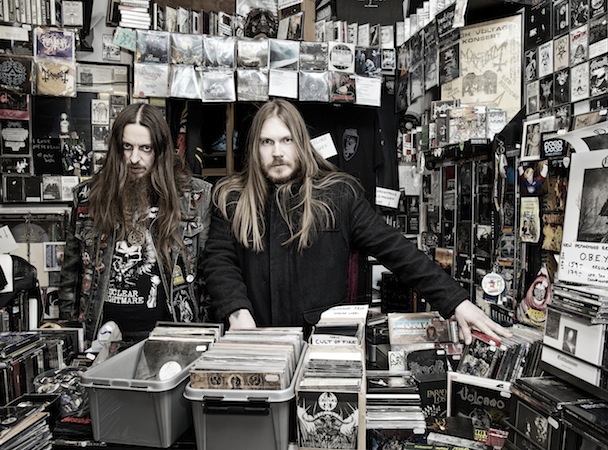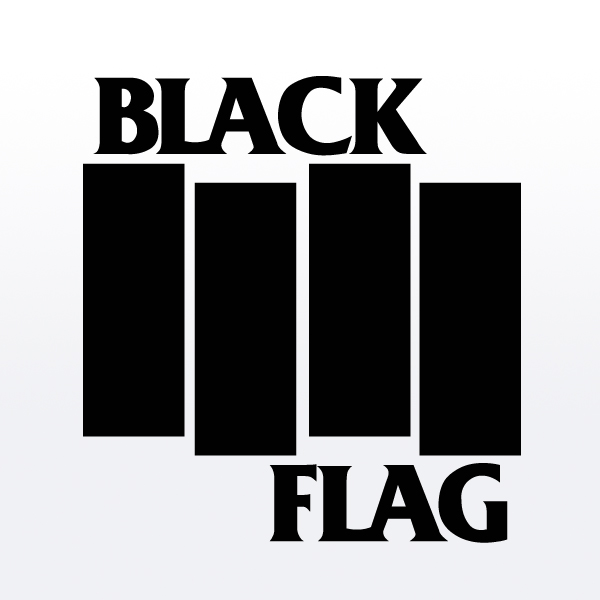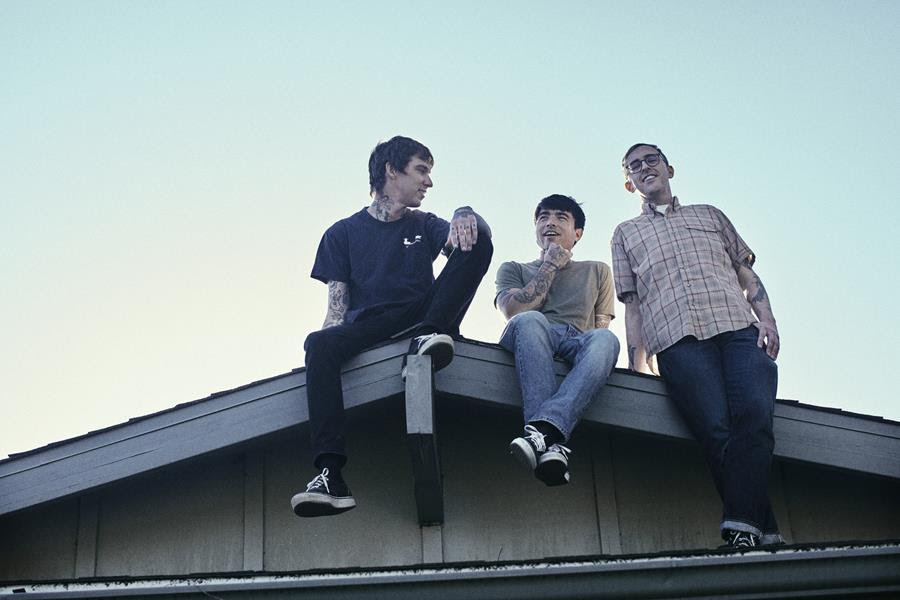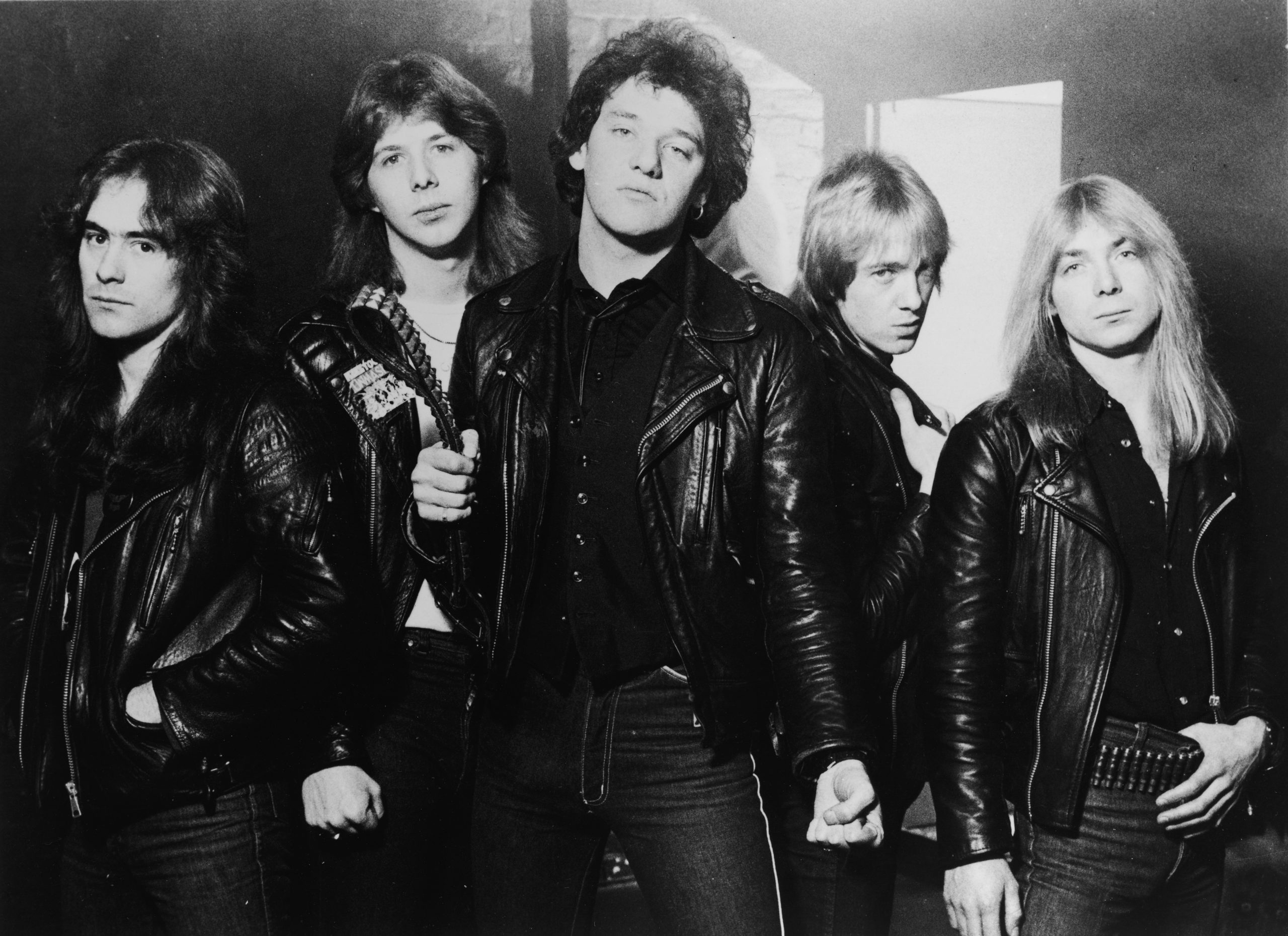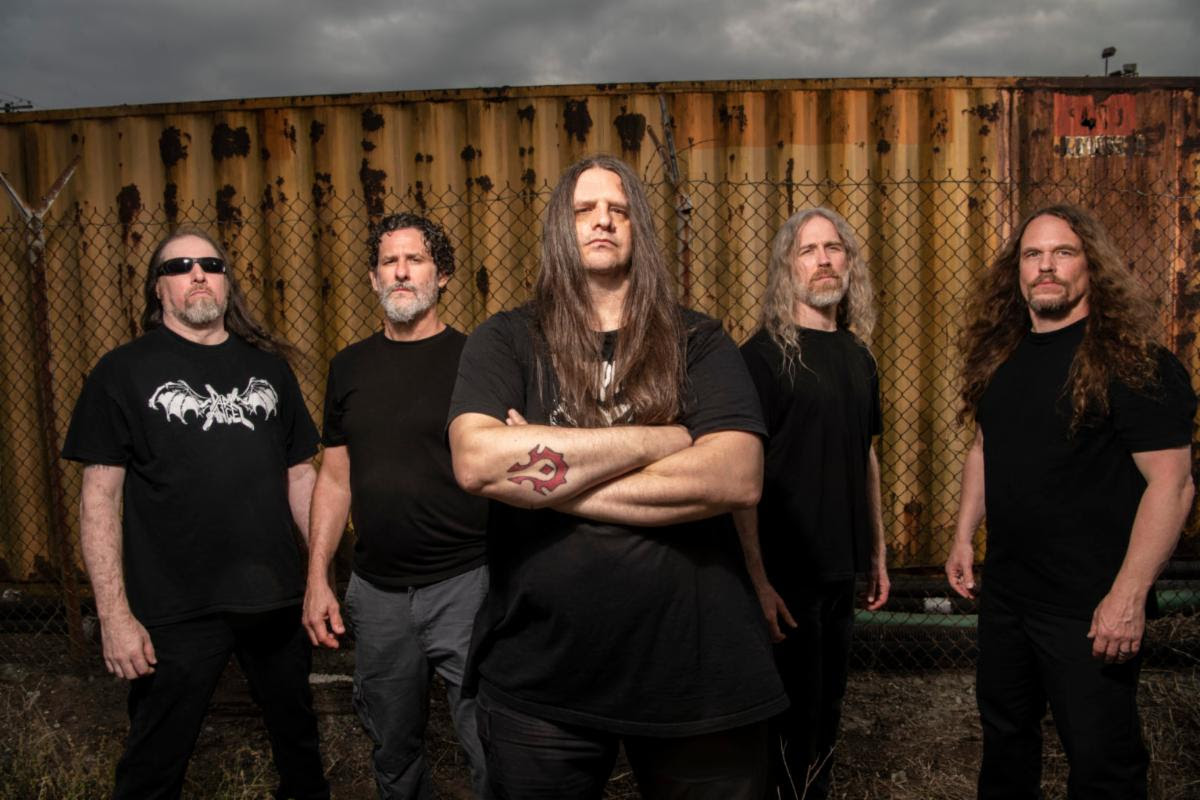Next month, Darkthrone will release The Underground Resistance, their 16th studio LP (or 15th, depending on how you catalog these things). It's been 26 years since their formation (as Black Death), 22 years since their first LP (the technical death-metal album Soulside Journey), and 21 years since they abandoned technical death metal to play primitive black metal, the genre they helped to define, in Norway, alongside Mayhem and Burzum and a host of lesser (or later) luminaries. Also worth noting: It's been 20 years since the band's rhythm guitarist, Ivar "Zephyrous" Enger, parted ways with Darkthrone, and thus two decades of the band existing as a duo: Gylve Nagell and Ted Skjellum, better known as Fenriz and Nocturno Culto, respectively.
That's a long time for any band to remain intact -- attrition claims most before they hit the decade mark -- much less a band in such a turbulent scene: If you didn't know, Norwegian black metal musicians are unusually prone to things like suicide, murder, and incarceration.
Like Zelig, Darkthrone were around for all of it -- the church-burnings, the homicides, the bigotry -- though they remained uninvolved with and untouched by nearly all the sensationalism, the madness. Darkthrone were part of the "Inner Circle" at Helvete, the record store run by Øystein "Euronymous" Aarseth, the Mayhem guitarist and architect of the Norwegian black metal scene. They were close friends and collaborators with Varg Vikernes, who played bass in Mayhem but made his own musical name as Burzum, before (and after) killing Euronymous. They were featured prominently in some of the scene's best-known ancillary documents: Peter Beste's book of photography, True Norwegian Black Metal; Aaron Aites's and Audrey Ewell's documentary film, Until The Light Takes Us; and hundreds -- maybe thousands -- of publications: newspapers, zines, blogs, magazines … Darkthrone are everywhere. (Heck, even before they were part of the Inner Circle, they were everywhere: Their logo -- which has remained consistent since Soulside Journey, and is probably the most famous and coolest metal logo this side of the Slayer slashes -- was drawn by Tomas Lindberg, lead singer of At The Gates and Disfear.)
The band is best known for what has been called the Unholy Trinity -- three consecutive LPs that came to define black metal: 1992's A Blaze In The Northern Sky, '93's Under A Funeral Moon, and '94's Transilvanian Hunger. Those albums changed not only the sound of black metal, but its look, too: While most metal album covers at the time were elaborate, colorful fantasies stuffed to claustrophobic capacity with gore, sci-fi, or Lovecraftian imagery, the Unholy Trinity featured stark images of solitary humans (who were painted white and garbed in black, and who looked like ghosts or vampires), like decayed frames from silent horror movies.
Get past the cover and into the grooves, and the sound was equally unexpected, dark, and degraded; the music featured on the Unholy Trinity albums sounds almost like an air recording or a cassette demo. This was a deliberate decision on the part of the band. Nocturno Culto had obtained a copy of Polish death metal band Vader's 1989 demo, Necrolust, and both he and Fenriz were inspired by the sound. As Fenriz has since noted: "It was not the usual copy [of the Necrolust demo]; Ted got a fucked-up copy, with lots of hissing in the background. We loved that."
It was a sound that hearkened back to the rudimentary recordings of '80s metal bands like Hellhammer and Venom, and the sparse production style would come to be known as necro. The necro sound has since become a defining quality of much black metal; even now, more than two decades later, it is prominent in the music of a growing wave of black metal artists who release music primarily (or exclusively) on cassette.
On the Unholy Trinity, Darkthrone abandoned the sounds of day and looked backward, finding new inspiration in bands like Mercyful Fate, Motörhead, and -- most prominently and most importantly -- Sweden's Bathory and Switzerland's Celtic Frost, the two first-wave [1] black metal bands whose blueprints Darkthrone would study like scripture, from which they would build a new church.
But the Unholy Trinity represents only three years of a career that now approaches the three-decade mark, and for two of those decades, Fenriz and Nocturno Culto have established a massive, weird discography, as well as a cult of personality. The two men are like two sides of a vinyl LP: inextricably connected yet utterly unique. Nocturno Culto is quiet, aloof, distant; he lives in Trysil, the forests of Norway, six hours from his bandmate. Fenriz is excitable, loud -- an endlessly quotable music obsessive who lives in the city, Oslo. Fenriz has called his band "the Steely Dan of black metal," partly because both Darkthrone and Steely Dan share a reticence toward live performance (more on that later), and partly because both are duos whose core members play numerous essential roles, and the absence of either member would mean the immediate dissolution of the band. Fenriz plays the drums, writes the lyrics, does the interviews (hundreds of interviews per year, he claims); Culto plays the guitar, the bass, sings, writes the riffs, and handles all aspects of the band's business dealings (they've been on two labels over the course of their career: Peaceville, from 1990 to '94; Moonfog from '95 to 2004; and back to Peaceville from 2005 to present day). Occasionally, Culto will do an interview, or Fenriz will play guitar; recently, both men have split songwriting and singing duties straight down the middle. To separate their contributions at this point would be to destroy the songs entirely, much like the music of Becker and Fagen. It's kind of hilarious, too, to consider Steely Dan's legendary studio perfectionism as an analogue to Darkthrone's legendary commitment to lo-fidelity. As Fenriz said in one interview:
i don't know of any other drummer that deliberately decided to UN-LEARN drums. i am not very interested in drummers, i quit playing drums with ambition in 1993. i don't like playing drums and i ONLY play drums when we rehearse the song and after playing through the song once we start to record. so i play drums maybe 10 hours a year. and didn't play anymore than that the last ten years and that's a fact. i prefer bass and vocals, but i also do not rehearse those instruments, i get a hellova lot of NERVE out of not practicing, i'm walking on thin ice and i crave it!!
These days, the band rehearses a couple times a year, if that. They had almost completely stopped playing live by '92, and they played their last gig ever in 1996 (a one-off event). In '92, Fenriz was vocal about his distaste for live performance, saying: "We don't play live anymore because of sound problems, silly trend audience, stagedivers (shoot 'em) and other financial and equipmental problems." Since then, he has become a vehement, vocal opponent of live music (although he claims to still attend shows as an audience member on a fairly regular basis).
To be sure, the demand for Darkthrone live shows is there. In a 2011 interview, Fenriz told Metal Maniacs that the band had been offered $200,000 (plus expenses) to play the 2007 Wacken Open-Air Festival in Germany. In 2008, he says, they were offered $150,000 to play Hellfest in France. But the band members keep their day jobs -- Culto is a schoolteacher; Fenriz works for the Norwegian postal service -- so they won't have to make any artistic compromises, including playing live.
Fenriz is a genuine (and self-proclaimed) music nerd -- along with Darkthrone, he's played in more than half a dozen other bands (most notably Isengard, Neptune Towers, and Fenriz' Red Planet); since 2009 he's run his Band Of The Week blog, which spotlights obscure metal bands that he's found via his extremely obsessive listening habits (As he notes, "Each year I go through 350 - 500 releases, whether it's a single, double album, demo, or DJ mix …. Every day I listen to at least 10 hours of music.") And Band Of The Week has been instrumental in launching the careers of some of the most talked-about metal bands of the last few years, including Ghost, Christian Mistress, and In Solitude, among many others. He closes nearly every interview with shouts out to the arcane bands he's listening to at the moment, the bands he wants you to hear, too.
That love of music is evident in every incarnation of Darkthrone. (The band's name is a combination of references: a Celtic Frost song called "Jewel Throne," with lyrics reading, "I am the king, sitting in the dark," along with a long-defunct Danish metal magazine called Blackthorn.) The band's work from 2007 to present day brings to life their oft-obscure, ancient heroes -- Fenriz has loudly denied any influence dating later than the '80s. But their career has been magnificently strange and diverse. In compiling this ranking of Darkthrone's albums, I took into account only their studio LPs. I also largely ignored the band's lyrics, which are frequently incomprehensible, although it should be noted that Fenriz is truly one of black metal's greatest and most thoughtful lyricists, and he's only gotten better and more interesting with age. His general themes can be broken into three periods: early (occult, death); middle (depression, isolation); and late (a meta-discussion of metal scene politics). As Fenriz himself notes, "The lyrics have changed, of course, because I'm really scared of people who haven't changed their stance since they were 14. Perspective is everything, as Aimee Mann says."
With that, let's begin our descent into the amazing catalog of black metal's essential band.
[1]That distinction -- first-wave and second-wave black metal -- is an important one. For our purposes, "black metal" will heretofore be defined as second wave and post-second wave: Darkthrone, Burzum, and Mayhem are the seminal bands of the second wave, and most of the black metal that is popular today -- everything from Krallice to Agalloch to Deafheaven -- is an extension or derivation of the second wave. The first wave is not so much a genre as an evolutionary link defined only in retrospect. But I'll let Fenriz tell you about that himself (from the great Until The Light Takes Us DVD bonus features):
[videoembed size="full_width" alignment="center"][/videoembed]
[videoembed size="full_width" alignment="center"][/videoembed]

There's almost no way to compare Darkthrone's debut with the rest of the band's catalog: The Darkthrone of Soulside Journey has virtually nothing in common with the reinvented (if not reborn) Darkthone that would emerge just one album later. First off, the band here is a quartet — by their next album they would be a trio; by their fourth album, 1994's Transilvanian Hunger, they were stripped down to the two-man configuration that the world would come to recognize as Darkthrone: Fenriz and Nocturno Culto. (Even their aliases were an album away; on Soulside Journey, the band members are credited under their real names, except Fenriz, who chose to be credited as "Hank Amarillo," as a joke.)
More noticeably, though, on Soulside Journey, Darkthrone were playing standard-issue late-'80s death metal — music built of deft technical precision, palm muted guitars, double-bass drums, screaming solos, abrupt time shifts, clear production, and structural complexity — not the raw, blurry, hypnotic black metal on which they would make their name (and which was, ultimately, the genre they would help to create) or the chant-along black 'n' roll that has become the hallmark of their triumphant second act.
Soulside Journey was recorded at Sunlight Studios in Stockholm, Sweden, with producer Tomas Skogsberg: basically the birthplace and midwife of Swedish death metal. Entombed, Grave, Dismember, At The Gates, and dozens of others recorded seminal work at Sunlight with Skogsberg. Perhaps naturally, then, Soulside Journey sounds a lot like the Swedish death metal that was on the rise at the time (and which has come back into vogue over the last few years), full of downtuned guitars made fat and fuzzy with a Boss HM-2 pedal.
Everything about that sound was completely abandoned by Darkthrone only one album later, when the band transitioned to black metal, and they would never look back (with one exception — 1996's Goatlord — which doesn't really count anyway, but we'll get to that shortly). As an early Swedish death metal album (recorded by a Norwegian band), Soulside Journey is totally worthwhile. The performances are uniformly excellent; the sound is crisp, crushing, full, and eerie. Still, it suffers in comparison to the two bodies of work to which it is naturally compared: (1) Darkthrone's own catalog, which includes some of black metal's defining documents; and (2) the classics of Swedish death metal — from Entombed's Left Hand Path to Dismember's Like An Ever Flowing Stream to At The Gates' Slaughter Of The Soul — which include some of death metal's defining documents. Soulside Journey is much better and more valuable than a mere curiosity, however, and it's tempting to wonder about the current state of the alternate reality in which Darkthrone continued on this path. But it's hard to imagine that reality being superior to the one in which we now live.
15. Soulside Journey (1991)
There's almost no way to compare Darkthrone's debut with the rest of the band's catalog: The Darkthrone of Soulside Journey has virtually nothing in common with the reinvented (if not reborn) Darkthone that would emerge just one album later. First off, the band here is a quartet — by their next album they would be a trio; by their fourth album, 1994's Transilvanian Hunger, they were stripped down to the two-man configuration that the world would come to recognize as Darkthrone: Fenriz and Nocturno Culto. (Even their aliases were an album away; on Soulside Journey, the band members are credited under their real names, except Fenriz, who chose to be credited as "Hank Amarillo," as a joke.)
More noticeably, though, on Soulside Journey, Darkthrone were playing standard-issue late-'80s death metal — music built of deft technical precision, palm muted guitars, double-bass drums, screaming solos, abrupt time shifts, clear production, and structural complexity — not the raw, blurry, hypnotic black metal on which they would make their name (and which was, ultimately, the genre they would help to create) or the chant-along black 'n' roll that has become the hallmark of their triumphant second act.
Soulside Journey was recorded at Sunlight Studios in Stockholm, Sweden, with producer Tomas Skogsberg: basically the birthplace and midwife of Swedish death metal. Entombed, Grave, Dismember, At The Gates, and dozens of others recorded seminal work at Sunlight with Skogsberg. Perhaps naturally, then, Soulside Journey sounds a lot like the Swedish death metal that was on the rise at the time (and which has come back into vogue over the last few years), full of downtuned guitars made fat and fuzzy with a Boss HM-2 pedal.
Everything about that sound was completely abandoned by Darkthrone only one album later, when the band transitioned to black metal, and they would never look back (with one exception — 1996's Goatlord — which doesn't really count anyway, but we'll get to that shortly). As an early Swedish death metal album (recorded by a Norwegian band), Soulside Journey is totally worthwhile. The performances are uniformly excellent; the sound is crisp, crushing, full, and eerie. Still, it suffers in comparison to the two bodies of work to which it is naturally compared: (1) Darkthrone's own catalog, which includes some of black metal's defining documents; and (2) the classics of Swedish death metal — from Entombed's Left Hand Path to Dismember's Like An Ever Flowing Stream to At The Gates' Slaughter Of The Soul — which include some of death metal's defining documents. Soulside Journey is much better and more valuable than a mere curiosity, however, and it's tempting to wonder about the current state of the alternate reality in which Darkthrone continued on this path. But it's hard to imagine that reality being superior to the one in which we now live.
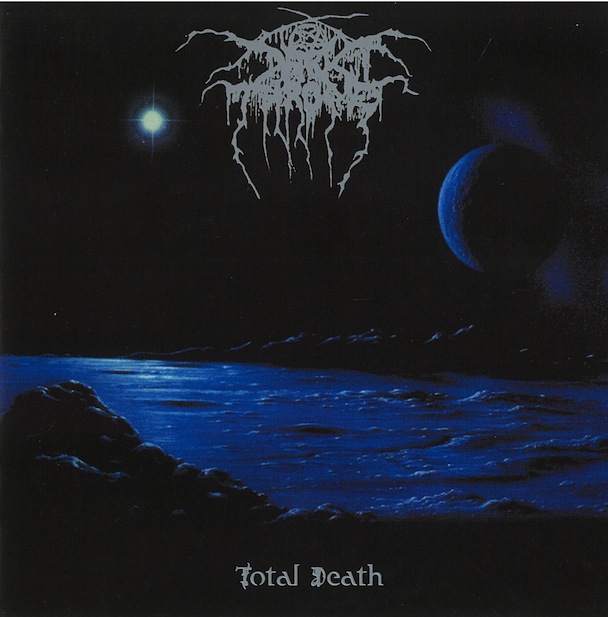
The four Darkthrone albums leading up to 1996's Total Death are unassailable classics, each one somehow building on, while moving away from, everything that preceded it. In hindsight, it seems likely this immense creative surge left Fenriz exhausted. Between 1991 and '96, Darkthrone cranked out a new album every year, and during that same period, Fenriz was also releasing new work with a handful of other projects, including Isengard, Neptune Towers, Dodheimsgard, Valhall, and Storm. This theory is lent some credence especially by the fact that following Total Death, Darkthrone released no new material for three full years, during which time nearly all of Fenriz's other projects went into hibernation, too.
But even before that blackout, there was evidence that Darkthrone's drummer was suffering from fatigue: Previously, Fenriz had been responsible for the band's cover art — and he produced some of the most recognizable images in heavy metal history, defining a genre aesthetic in the process — but for Total Death, he ceded that responsibility, saying later he had "lost interest in the visual thing." (This led to a series of generic, occasionally ugly album covers that lasted until 2007, when Fenriz was finally again ready to take over that aspect of the band's production cycle.) Prior to Total Death, Fenriz had written all Darkthrone's lyrics (except for five songs across two albums penned by Burzum's Varg Vikernes); this time around, however, Fenriz contributed no lyrics whatsoever — Nocturno Culto wrote lyrics for half the album's tracks, the other half came courtesy of scene luminaries: Garm of Ulver; Ihsahn of Emperor; Carl-Michael Eide of Ved Buens Ende; and Satyr of Satyricon. Finally, while the two albums preceding Total Death were recorded at the band's 4-track home studio, Necrohell, this one was recorded in a traditional studio, Ancient Spectre Ruins.
None of these chemical changes should necessarily have resulted in a lesser work, but Total Death is a mediocre Darkthrone album just the same, and it suffers especially in comparison to the four masterworks that precede it. Total Death continues down the songwriting path set off on by the band on their previous album, 1995's Panzerfaust, minus that album's wintry hypnotic blasts: These are all big Celtic Frost riffs set to mid-tempo rhythms, played loud and loose. But even in this regard, the edges have been sanded down; the loose ends and knots neatly trimmed. While Panzerfaust feels like a Cessna in a snowstorm piloted by a pair of drunks, Total Death feels like a Gulfstream 200 cruising into a patch of mild turbulence. The production here is a good deal cleaner, and the mix fuller, than anything on the four albums that preceded it — and that's not an unwelcome stylistic shift, either, but all these factors combine to achieve a general air of ambivalence and sluggishness, qualities not evident on any prior Darkthrone release.
Still, these are not criticisms of Total Death, exactly, but Total Death in relation to the body of work surrounding it (and especially preceding it). Many fans claim Total Death is the first "inessential" Darkthrone album, but that's simply not true: It follows Soulside Journey in that regard. Many claim Total Death marks the beginning of a mid-career lull, but even that seems inaccurate: It's a logical stylistic evolution from Panzerfaust, followed by a three-year hiatus — an absence exactly half as long as the band's time in the public eye to that point. If anything, Total Death is the final chapter of Darkthrone, Part 1, not the first chapter of Darkthrone, Part 2 (it's sort of a neat bookend to Soulside Journey in some ways). And while Total Death may not be a heavyweight champion, it still knows how to kick some ass. If you're sitting around at night, drinking or bullshitting or whatever, and you throw it on the stereo, before you know it, your fist will be pumping. Your blood, too.
14. Total Death (1996)
The four Darkthrone albums leading up to 1996's Total Death are unassailable classics, each one somehow building on, while moving away from, everything that preceded it. In hindsight, it seems likely this immense creative surge left Fenriz exhausted. Between 1991 and '96, Darkthrone cranked out a new album every year, and during that same period, Fenriz was also releasing new work with a handful of other projects, including Isengard, Neptune Towers, Dodheimsgard, Valhall, and Storm. This theory is lent some credence especially by the fact that following Total Death, Darkthrone released no new material for three full years, during which time nearly all of Fenriz's other projects went into hibernation, too.
But even before that blackout, there was evidence that Darkthrone's drummer was suffering from fatigue: Previously, Fenriz had been responsible for the band's cover art — and he produced some of the most recognizable images in heavy metal history, defining a genre aesthetic in the process — but for Total Death, he ceded that responsibility, saying later he had "lost interest in the visual thing." (This led to a series of generic, occasionally ugly album covers that lasted until 2007, when Fenriz was finally again ready to take over that aspect of the band's production cycle.) Prior to Total Death, Fenriz had written all Darkthrone's lyrics (except for five songs across two albums penned by Burzum's Varg Vikernes); this time around, however, Fenriz contributed no lyrics whatsoever — Nocturno Culto wrote lyrics for half the album's tracks, the other half came courtesy of scene luminaries: Garm of Ulver; Ihsahn of Emperor; Carl-Michael Eide of Ved Buens Ende; and Satyr of Satyricon. Finally, while the two albums preceding Total Death were recorded at the band's 4-track home studio, Necrohell, this one was recorded in a traditional studio, Ancient Spectre Ruins.
None of these chemical changes should necessarily have resulted in a lesser work, but Total Death is a mediocre Darkthrone album just the same, and it suffers especially in comparison to the four masterworks that precede it. Total Death continues down the songwriting path set off on by the band on their previous album, 1995's Panzerfaust, minus that album's wintry hypnotic blasts: These are all big Celtic Frost riffs set to mid-tempo rhythms, played loud and loose. But even in this regard, the edges have been sanded down; the loose ends and knots neatly trimmed. While Panzerfaust feels like a Cessna in a snowstorm piloted by a pair of drunks, Total Death feels like a Gulfstream 200 cruising into a patch of mild turbulence. The production here is a good deal cleaner, and the mix fuller, than anything on the four albums that preceded it — and that's not an unwelcome stylistic shift, either, but all these factors combine to achieve a general air of ambivalence and sluggishness, qualities not evident on any prior Darkthrone release.
Still, these are not criticisms of Total Death, exactly, but Total Death in relation to the body of work surrounding it (and especially preceding it). Many fans claim Total Death is the first "inessential" Darkthrone album, but that's simply not true: It follows Soulside Journey in that regard. Many claim Total Death marks the beginning of a mid-career lull, but even that seems inaccurate: It's a logical stylistic evolution from Panzerfaust, followed by a three-year hiatus — an absence exactly half as long as the band's time in the public eye to that point. If anything, Total Death is the final chapter of Darkthrone, Part 1, not the first chapter of Darkthrone, Part 2 (it's sort of a neat bookend to Soulside Journey in some ways). And while Total Death may not be a heavyweight champion, it still knows how to kick some ass. If you're sitting around at night, drinking or bullshitting or whatever, and you throw it on the stereo, before you know it, your fist will be pumping. Your blood, too.
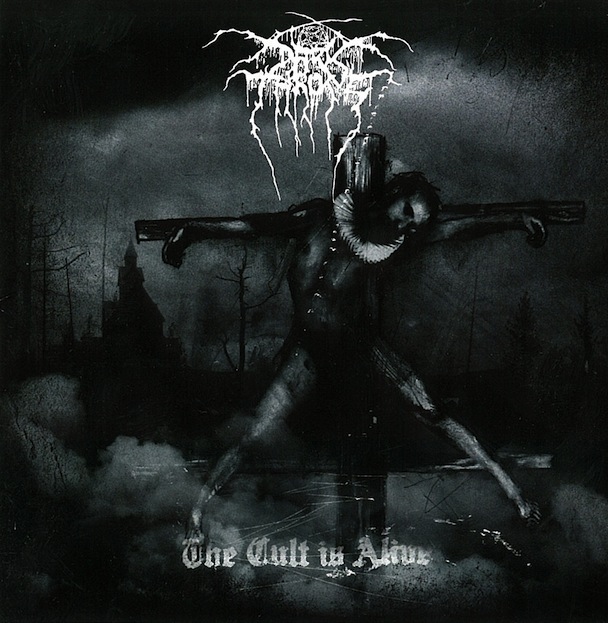
Darkthrone had begun a transition from second-generation black metal to '70s- and '80s-influenced hard rock and thrash on … well, it goes back to '95's Panzerfaust, really, and it's evident on every album after that one, too, with the notable exceptions of '99's Ravishing Grimness and 2001's Plaguewielder. But on 2006's The Cult Is Alive, the band made what felt like a sudden shift; it seemed as though they were announcing for themselves a new identity. They weren't, but even with the benefit of hindsight and context, The Cult Is Alive can feel a bit jarring.
In many ways, it is an album of firsts: Notably, it is the first Darkthrone album where Burzum- and Bathory-esque black metal is truly an almost unnoticeable influence — here, the band is openly deriving its inspiration from punk and metal bands like Motörhead and Discharge. It's also the first album (excluding the unrepresentative Goatlord) where Fenriz contributes a lead vocal (starting with The Cult Is Alive, Fenriz and Nocturno Culto would split vocal duties much more evenly — not always to the band's benefit). It's the first album recorded in the band's portable Necrohell 2 studio, and the sound is rawer than anything since Panzerfaust (the last recorded in their home studio Necrohell). It's the first album for which Darkthrone made a video (for album highlight "Too Old Too Cold," which was also the title track of a five-song EP released in 2005). And it's the first album of the band's post-Moonfog era.
In retrospect, The Cult Is Alive is a good album, but it falls short of the albums Darkthrone have produced since — which use similar themes and influences to greater ends — as well as the post-Total Death transitional albums that precede it, which forced Culto to grow as a songwriter and guitarist while Fenriz was sidelined due to burnout and depression.
The Cult Is Alive's virtues are its focus — which the band would later put to better use — its raw power, Culto's incredible guitar solos, and the mostly comprehensible lyrics, which by this point have frequently become a commentary on the thing Fenriz knows best: the state of heavy metal and Fenriz's dissatisfaction with such. The album's most quoted line comes from "Too Old Too Cold," when Culto snarls, "You call your metal black? It's just spastic, lame, and weak."
13. The Cult Is Alive (2006)
Darkthrone had begun a transition from second-generation black metal to '70s- and '80s-influenced hard rock and thrash on … well, it goes back to '95's Panzerfaust, really, and it's evident on every album after that one, too, with the notable exceptions of '99's Ravishing Grimness and 2001's Plaguewielder. But on 2006's The Cult Is Alive, the band made what felt like a sudden shift; it seemed as though they were announcing for themselves a new identity. They weren't, but even with the benefit of hindsight and context, The Cult Is Alive can feel a bit jarring.
In many ways, it is an album of firsts: Notably, it is the first Darkthrone album where Burzum- and Bathory-esque black metal is truly an almost unnoticeable influence — here, the band is openly deriving its inspiration from punk and metal bands like Motörhead and Discharge. It's also the first album (excluding the unrepresentative Goatlord) where Fenriz contributes a lead vocal (starting with The Cult Is Alive, Fenriz and Nocturno Culto would split vocal duties much more evenly — not always to the band's benefit). It's the first album recorded in the band's portable Necrohell 2 studio, and the sound is rawer than anything since Panzerfaust (the last recorded in their home studio Necrohell). It's the first album for which Darkthrone made a video (for album highlight "Too Old Too Cold," which was also the title track of a five-song EP released in 2005). And it's the first album of the band's post-Moonfog era.
In retrospect, The Cult Is Alive is a good album, but it falls short of the albums Darkthrone have produced since — which use similar themes and influences to greater ends — as well as the post-Total Death transitional albums that precede it, which forced Culto to grow as a songwriter and guitarist while Fenriz was sidelined due to burnout and depression.
The Cult Is Alive's virtues are its focus — which the band would later put to better use — its raw power, Culto's incredible guitar solos, and the mostly comprehensible lyrics, which by this point have frequently become a commentary on the thing Fenriz knows best: the state of heavy metal and Fenriz's dissatisfaction with such. The album's most quoted line comes from "Too Old Too Cold," when Culto snarls, "You call your metal black? It's just spastic, lame, and weak."
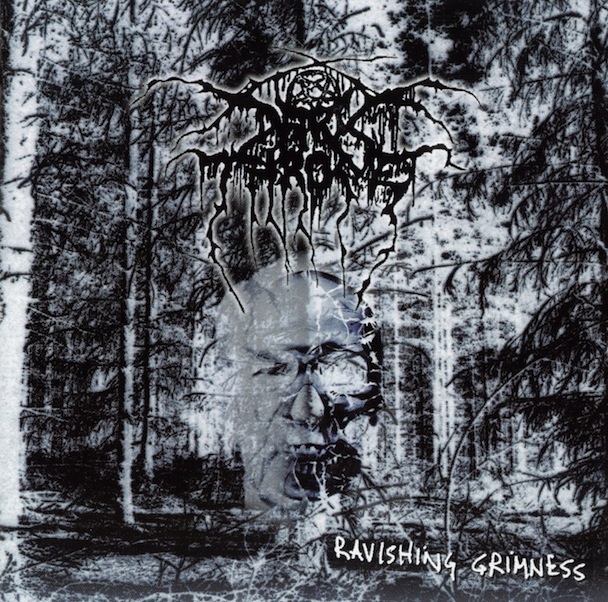
From 1991 to '96, Darkthrone had been turning out a new album every year, so when they disappeared after '96's lackluster Total Death, many fans believed the band had broken up. Those beliefs were eventually proven incorrect, but they weren't without substance. It was three years between Total Death and its follow-up, 1999's Ravishing Grimness, but even the duration of that extended delay doesn't adequately capture that band's fractured state during that period. In a '99 interview promoting Ravishing Grimness, Fenriz described something like ennui when asked about the long delay between albums:
We weren't really that hungry anymore, we made a lot of albums in the past… We didn't have that itch to do more. We don't have to think of our career and we can do what we want. We haven't been in the studio since '95, so it's been four years. It seemed more like one and a half years. Time goes by so quickly.
In 2002, Fenriz claimed that after Total Death, he went through "an obligatory acid psychedelic period, lasting for about two years." Whatever the cause for his retreat into isolation, Fenriz had left almost all Darkthrone responsibilities in Nocturno Culto's hands; Fenriz has since admitted that if not for the vocalist/guitarist's choice to step up, Darkthrone might have died unceremoniously during that period. But Fenriz did continue to write lyrics — lyrics he later called "hard … painful … they scare me" — and around those lyrics, Culto wrote a new set of songs, which would become the bulk of Ravishing Grimness: Culto wrote all the music for five of the album's six songs; the sixth, "The Beast," was written by Fenriz, and its pub-metal feel stands in stark contrast to the atmospheric black metal Culto was writing at the time. Culto also conceived of the cover art, which is one of the cheapest-looking sleeves since the birth of the compact disc. (The band has since reissued these mid-career albums with greatly improved cover art.)
Fenriz has said in numerous places that he suffered from depression between 1999 and 2003 or so, and even in absentia, his despair and frustration can be felt here. Beyond "The Beast," even Fenriz's minimal contributions to Ravishing Grimness seem self-destructive: Culto's songs are something of a return to the band's black metal roots, but Fenriz chooses to abandon the standard rhythms of black metal (i.e., hyperspeed blast beats) in favor of a slow- to mid-tempo pace, which doesn't work especially well. Years later, Fenriz was still defending this unpopular decision — "I can assure you that the way I end up playing drums on Ravishing Grimness is purely by choice, and it is JUST the way I want drumming to be in black metal. Not many others agree on this."
He's not wrong about that: Ravishing Grimness has earned a reputation as one of Darkthrone's weakest albums, although Culto's estimable contributions warrant better — his guitar work has rarely been more impressive; it's melodic and spacious and hypnotizing (FWIW, Grimness contains some of my own favorite mid-period Darkthrone riffs), and had the album been recorded in different circumstances, it's easy to see ways these songs could rank in the upper half of Darkthrone's catalog. But history can't be rewritten; that fissure between the two men — and Fenriz's troubled psychological state — is at the heart of the album's creation. If anything, Ravishing Grimness should be remembered fondly not only for its positive attributes, but for being a way station that allowed the band to continue. Years later, Fenriz credited Culto for keeping the band alive during this time, saying, "Nocturno Culto is the sanest soul in Darkthrone in [the Ravishing Grimness] period, so he takes care of most of the music and business. Thanks, Ted."
12. Ravishing Grimness (1999)
From 1991 to '96, Darkthrone had been turning out a new album every year, so when they disappeared after '96's lackluster Total Death, many fans believed the band had broken up. Those beliefs were eventually proven incorrect, but they weren't without substance. It was three years between Total Death and its follow-up, 1999's Ravishing Grimness, but even the duration of that extended delay doesn't adequately capture that band's fractured state during that period. In a '99 interview promoting Ravishing Grimness, Fenriz described something like ennui when asked about the long delay between albums:
We weren't really that hungry anymore, we made a lot of albums in the past… We didn't have that itch to do more. We don't have to think of our career and we can do what we want. We haven't been in the studio since '95, so it's been four years. It seemed more like one and a half years. Time goes by so quickly.
In 2002, Fenriz claimed that after Total Death, he went through "an obligatory acid psychedelic period, lasting for about two years." Whatever the cause for his retreat into isolation, Fenriz had left almost all Darkthrone responsibilities in Nocturno Culto's hands; Fenriz has since admitted that if not for the vocalist/guitarist's choice to step up, Darkthrone might have died unceremoniously during that period. But Fenriz did continue to write lyrics — lyrics he later called "hard … painful … they scare me" — and around those lyrics, Culto wrote a new set of songs, which would become the bulk of Ravishing Grimness: Culto wrote all the music for five of the album's six songs; the sixth, "The Beast," was written by Fenriz, and its pub-metal feel stands in stark contrast to the atmospheric black metal Culto was writing at the time. Culto also conceived of the cover art, which is one of the cheapest-looking sleeves since the birth of the compact disc. (The band has since reissued these mid-career albums with greatly improved cover art.)
Fenriz has said in numerous places that he suffered from depression between 1999 and 2003 or so, and even in absentia, his despair and frustration can be felt here. Beyond "The Beast," even Fenriz's minimal contributions to Ravishing Grimness seem self-destructive: Culto's songs are something of a return to the band's black metal roots, but Fenriz chooses to abandon the standard rhythms of black metal (i.e., hyperspeed blast beats) in favor of a slow- to mid-tempo pace, which doesn't work especially well. Years later, Fenriz was still defending this unpopular decision — "I can assure you that the way I end up playing drums on Ravishing Grimness is purely by choice, and it is JUST the way I want drumming to be in black metal. Not many others agree on this."
He's not wrong about that: Ravishing Grimness has earned a reputation as one of Darkthrone's weakest albums, although Culto's estimable contributions warrant better — his guitar work has rarely been more impressive; it's melodic and spacious and hypnotizing (FWIW, Grimness contains some of my own favorite mid-period Darkthrone riffs), and had the album been recorded in different circumstances, it's easy to see ways these songs could rank in the upper half of Darkthrone's catalog. But history can't be rewritten; that fissure between the two men — and Fenriz's troubled psychological state — is at the heart of the album's creation. If anything, Ravishing Grimness should be remembered fondly not only for its positive attributes, but for being a way station that allowed the band to continue. Years later, Fenriz credited Culto for keeping the band alive during this time, saying, "Nocturno Culto is the sanest soul in Darkthrone in [the Ravishing Grimness] period, so he takes care of most of the music and business. Thanks, Ted."
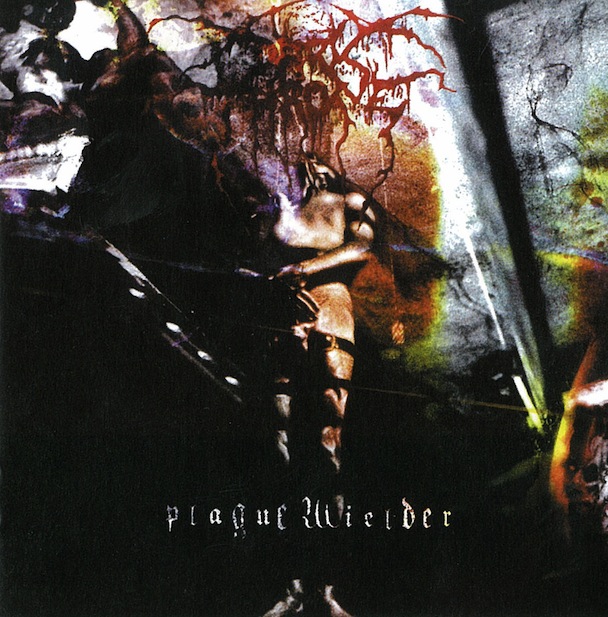
Even though Darkthrone has certain very identifiable artistic periods — the primitive black metal of 1992 - '94; the punk-influenced thrash of 2007 - '10 — Fenriz has said that only two Darkthrone albums are essentially the same: "Ravishing Grimness and Plaguewielder, from '99 and '01 [respectively]."
He's not wrong: Both Plaguewielder and the album that precede it have similar backstories and constructions. Each contains six songs, music for five of which was written by Nocturno Culto, with Fenriz contributing all the lyrics and one full song per album. Both albums were recorded while Fenriz was undergoing "severe depression," which played a role in his minimized participation. On both albums, Culto's songs are epic and melodic black metal of the atmospheric variety, while Fenriz's contributions are basic metal-charged rockers. Both albums were recorded at Studio Studio in Toten, Norway, and they sound fuller and cleaner than the raw metal for which Darkthrone is best known. The primary difference is the drumming: On Ravishing Grimness, Fenriz slowed down his rhythms to a pace that didn't seem to be related to the music; on Plaguewielder, Fenriz's performances are more upbeat. It has been suggested that the change in style was forced by Culto, who was reportedly not happy with Fenriz's playing on Ravishing Grimness. While the specifics of that fracture remain behind closed doors, Culto has admitted that he made certain suggestions regarding the percussion on Plaguewielder:
Sometimes I have to decide things for [Fenriz] because at times we disagree, but [on Plaguewielder] the music itself forced us to play more technically. I told him that when he is doing small technical stuff on the drums, in the tempo that Darkthrone are playing, I think it's brilliant. I actually tell him that a lot and say that maybe it's right to do those tiny things because he is doing those so fucking great. But he despises the drums a tiny bit.
Plaguewielder is considered by most Darkthrone fans to be the band's absolute nadir — owing in no small part to the album's cover(!), which is the first and only Darkthrone sleeve to feature a full spectrum of colors (as opposed to stark black and white with occasional blue tones), and is — to be fair to the haters — truly, incomprehensibly offensive to the eye. In retrospect, though, the album has few critical flaws, and nothing at all that merits disdain: Culto's vocals and guitar work are fantastic, and his riffs are uniformly engaging; the sharp, robust production brings to the fore details of the performances that might have been lost given a more necro approach; and Fenriz's drumming sounds pretty goddamn great. The greatest sin committed by Plaguewielder is simply that it feels a bit generic: There's no shortage in this world of ably performed atmospheric black metal, and Plaguewielder brings nothing new to that subgenre, while also sort of burying its creators' musical identities in the process. Like Ravishing Grimness, the album is probably more worthwhile for keeping the band alive when they were on the verge of death than it is for any musical contributions, but it's not without its thrills (album closer "Wreak" is a stunning epic). If Ravishing Grimness and Plaguewielder are indeed the same album, then a savvy editor ought to come in, chop that beast in half, and release a six-song Ravishing Plague LP that might not rank with Darkthrone's best work, but would certainly provide a much more flattering portrait of Darkthrone's unjustly maligned midlife crisis.
11. Plaguewielder (2001)
Even though Darkthrone has certain very identifiable artistic periods — the primitive black metal of 1992 - '94; the punk-influenced thrash of 2007 - '10 — Fenriz has said that only two Darkthrone albums are essentially the same: "Ravishing Grimness and Plaguewielder, from '99 and '01 [respectively]."
He's not wrong: Both Plaguewielder and the album that precede it have similar backstories and constructions. Each contains six songs, music for five of which was written by Nocturno Culto, with Fenriz contributing all the lyrics and one full song per album. Both albums were recorded while Fenriz was undergoing "severe depression," which played a role in his minimized participation. On both albums, Culto's songs are epic and melodic black metal of the atmospheric variety, while Fenriz's contributions are basic metal-charged rockers. Both albums were recorded at Studio Studio in Toten, Norway, and they sound fuller and cleaner than the raw metal for which Darkthrone is best known. The primary difference is the drumming: On Ravishing Grimness, Fenriz slowed down his rhythms to a pace that didn't seem to be related to the music; on Plaguewielder, Fenriz's performances are more upbeat. It has been suggested that the change in style was forced by Culto, who was reportedly not happy with Fenriz's playing on Ravishing Grimness. While the specifics of that fracture remain behind closed doors, Culto has admitted that he made certain suggestions regarding the percussion on Plaguewielder:
Sometimes I have to decide things for [Fenriz] because at times we disagree, but [on Plaguewielder] the music itself forced us to play more technically. I told him that when he is doing small technical stuff on the drums, in the tempo that Darkthrone are playing, I think it's brilliant. I actually tell him that a lot and say that maybe it's right to do those tiny things because he is doing those so fucking great. But he despises the drums a tiny bit.
Plaguewielder is considered by most Darkthrone fans to be the band's absolute nadir — owing in no small part to the album's cover(!), which is the first and only Darkthrone sleeve to feature a full spectrum of colors (as opposed to stark black and white with occasional blue tones), and is — to be fair to the haters — truly, incomprehensibly offensive to the eye. In retrospect, though, the album has few critical flaws, and nothing at all that merits disdain: Culto's vocals and guitar work are fantastic, and his riffs are uniformly engaging; the sharp, robust production brings to the fore details of the performances that might have been lost given a more necro approach; and Fenriz's drumming sounds pretty goddamn great. The greatest sin committed by Plaguewielder is simply that it feels a bit generic: There's no shortage in this world of ably performed atmospheric black metal, and Plaguewielder brings nothing new to that subgenre, while also sort of burying its creators' musical identities in the process. Like Ravishing Grimness, the album is probably more worthwhile for keeping the band alive when they were on the verge of death than it is for any musical contributions, but it's not without its thrills (album closer "Wreak" is a stunning epic). If Ravishing Grimness and Plaguewielder are indeed the same album, then a savvy editor ought to come in, chop that beast in half, and release a six-song Ravishing Plague LP that might not rank with Darkthrone's best work, but would certainly provide a much more flattering portrait of Darkthrone's unjustly maligned midlife crisis.
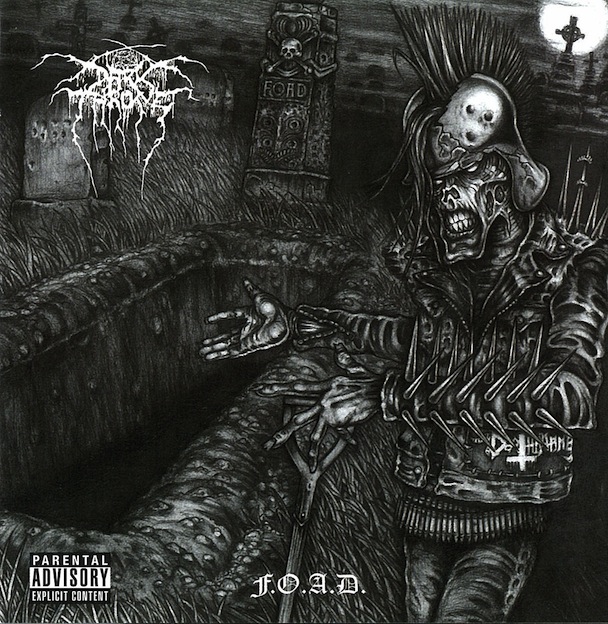
After The Cult Is Alive, Darkthrone fully embraced their new identity as … a retro metal band, really. To be fair, they'd be looking backward since 1992's A Blaze In The Northern Sky, but as the gap between their release dates and the release dates of their influences widened, Darkthrone's albums sounded increasingly anachronistic. By F.O.A.D., they weren't just appropriating Celtic Frost riffs; they sounded like Pentagram by way of Thin Lizzy, and they were dropping old-school references into half their songs.
F.O.A.D.'s most notable songs are the ones in which Darkthrone are challenging their fans' taste: "Canadian Metal" pays tribute to north-of-the-border obscurities like Razor, Slaughter, and Piledriver. "The Church Of Real Metal" is built around muscular riffs that sound like Black Sabbath or AC/DC, with a chorus that simply repeats the song's truer-than-thou title. "Raised On Rock" is the most accusatory track here (no small feat on an album whose title is an acronym for "Fuck Off And Die"); it almost entirely sums up Fenriz's disgust with the state of his surroundings:
You have nothing in common with me/ You think old-school is 1993/ Ha! I've been a thrasher since '84/ Almost nothing sounds true anymore.I've made my own code/ sold my soul to Manilla Road/ Modern metal I don't give a fuck/ UH! I was raised on rock.
It went plastic in '94/ Oh my god you're such a bore/ If you don't understand what I mean/ Fucking listen to Venom's "Acid Queen."
All the references here — Venom, Manilla Road, the "UH!", which is a nod to Celtic Frost frontman Tom G. Warrior's trademark "death grunt" — reflect Darkthrone's own approach to sound and songwriting. Riffs and lyrics such as these would never have found their way onto Transilvanian Hunger (or even Total Death). And the challenge they're presenting is not only that fans follow them into these new (old) territories, but that they familiarize themselves with the influences flaunted by Darkthrone. It's hugely arrogant, of course, but it's also musically compelling, especially Culto's contributions; here, his guitar work has reached sublime levels: chainsaw-buzzing through anthemic riffs, spiraling off into unexpected, astonishing prog or trad-metal leads.
F.O.A.D. is the first album since '95's Panzerfaust on which Fenriz was in charge of the artwork, and he commissioned graphic artist Dennis Dread to draw something for the band — here, Dread created for Darkthrone a mascot, much like Iron Maiden's Eddie: Mr. Necro. Dread drew covers for the next two Darkthrone albums, too (though he's absent from the forthcoming The Underground Resistance), both of which follow the undead mascot through his Darkthrone-inspired fantasy-punk adventures, and the three albums featuring Dread artwork feel like something of a trilogy. On the whole, F.O.A.D. is probably the least essential piece of that trilogy, but its highlights are as good anything on the albums that would follow.
10. F.O.A.D. (2007)
After The Cult Is Alive, Darkthrone fully embraced their new identity as … a retro metal band, really. To be fair, they'd be looking backward since 1992's A Blaze In The Northern Sky, but as the gap between their release dates and the release dates of their influences widened, Darkthrone's albums sounded increasingly anachronistic. By F.O.A.D., they weren't just appropriating Celtic Frost riffs; they sounded like Pentagram by way of Thin Lizzy, and they were dropping old-school references into half their songs.
F.O.A.D.'s most notable songs are the ones in which Darkthrone are challenging their fans' taste: "Canadian Metal" pays tribute to north-of-the-border obscurities like Razor, Slaughter, and Piledriver. "The Church Of Real Metal" is built around muscular riffs that sound like Black Sabbath or AC/DC, with a chorus that simply repeats the song's truer-than-thou title. "Raised On Rock" is the most accusatory track here (no small feat on an album whose title is an acronym for "Fuck Off And Die"); it almost entirely sums up Fenriz's disgust with the state of his surroundings:
You have nothing in common with me/ You think old-school is 1993/ Ha! I've been a thrasher since '84/ Almost nothing sounds true anymore.I've made my own code/ sold my soul to Manilla Road/ Modern metal I don't give a fuck/ UH! I was raised on rock.
It went plastic in '94/ Oh my god you're such a bore/ If you don't understand what I mean/ Fucking listen to Venom's "Acid Queen."
All the references here — Venom, Manilla Road, the "UH!", which is a nod to Celtic Frost frontman Tom G. Warrior's trademark "death grunt" — reflect Darkthrone's own approach to sound and songwriting. Riffs and lyrics such as these would never have found their way onto Transilvanian Hunger (or even Total Death). And the challenge they're presenting is not only that fans follow them into these new (old) territories, but that they familiarize themselves with the influences flaunted by Darkthrone. It's hugely arrogant, of course, but it's also musically compelling, especially Culto's contributions; here, his guitar work has reached sublime levels: chainsaw-buzzing through anthemic riffs, spiraling off into unexpected, astonishing prog or trad-metal leads.
F.O.A.D. is the first album since '95's Panzerfaust on which Fenriz was in charge of the artwork, and he commissioned graphic artist Dennis Dread to draw something for the band — here, Dread created for Darkthrone a mascot, much like Iron Maiden's Eddie: Mr. Necro. Dread drew covers for the next two Darkthrone albums, too (though he's absent from the forthcoming The Underground Resistance), both of which follow the undead mascot through his Darkthrone-inspired fantasy-punk adventures, and the three albums featuring Dread artwork feel like something of a trilogy. On the whole, F.O.A.D. is probably the least essential piece of that trilogy, but its highlights are as good anything on the albums that would follow.
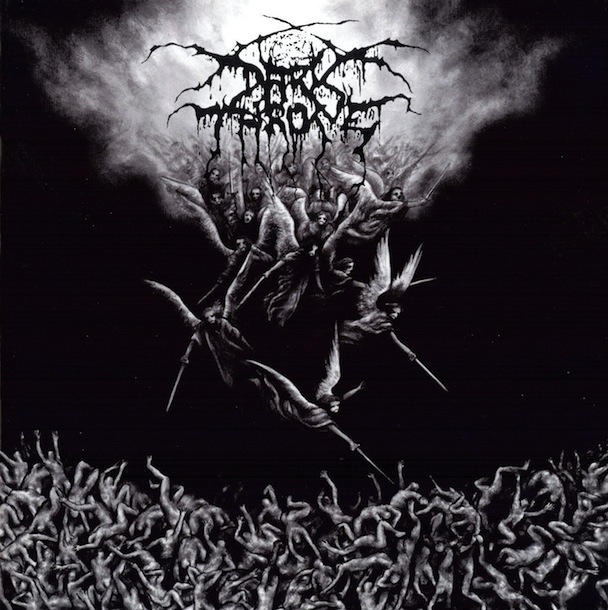
Darkthrone found a new creative energy starting with 2003's Hate Them, and coming off the recording of that album, that started immediately on its follow-up, 2004's Sardonic Wrath. (That title is borrowed from a line in the Satanic Bible's The Book Of Satan: "I blast out the ghastly contents of philosophically whited sepulchers and laugh with sardonic wrath!")
Sardonic Wrath was recorded in Oslo over six days in April 2003 with engineer Lars Klokkerhaug, who also worked with the band on Hate Them, and surely because of Klokkerhaug's involvement, as well as the band's rush to get back to work, Sardonic Wrath feels like something of a continuation of its predecessor. Again the band is dealing in riff-based, crushingly heavy, mostly mid-paced black 'n' roll, with Fenriz contributing some complete songs (as well as all lyrics); again the sound balances gnashing rawness with studio sheen. Sardonic Wrath feels a bit darker than Hate Them, but such comparisons are made on a finely calibrated scale, and are extremely relative by any standard.
Darkthrone dedicated Sardonic Wrath to Quorthon of Bathory, who passed away a couple months after Darkthrone completed work on the album, and the death of their primary musical influence almost feels like an apt punctuation here. Sardonic Wrath represents the end of a couple aspects of Darkthrone's career: It's their final album with Moonfog (with whom they'd been releasing records since 1995's Panzerfaust), and their last album that could even loosely be termed "black metal."
Looking back now, the band's entire tenure with Moonfog seems like a transitory era. Panzerfaust was the first album on which Darkthrone steered away from the second-generation black metal to which they had given birth; it's a terrific album, to be sure, but plainly the work of a band in search of a new voice. And after that, the duo seemed somewhat adrift, uncertain (even when the results were strong): from the lackluster black 'n' roll of Total Death to the epic atmospheric black metal of Ravishing Grimness and Plaguewielder (from which Fenriz was mostly absent) to the punishingly heavy but decidedly riff- and rhythm-based Hate Them and Sardonic Wrath. Once they returned to Peaceville — with whom they released their first three albums — for 2006's The Cult Is Alive, they seemed to have found the voice for which they were searching during the Moonfog years. That shouldn't be read as an indictment of the label, nor of the work Darkthrone produced while on that label — it's just an odd coincidence of timing.
Bizarrely, Sardonic Wrath was nominated for best metal album of 2004 in Norway's prestigious Alarm Awards — an honor the band flatly refused. Said Fenriz, "We play real and honest black metal. And we have no interest in being part of the glitter and showbiz side of the music industry."
That reaction led to Sardonic Wrath being removed from the voter's ballot, which more or less pleased the band.
"I am not against awards in general," said Fenriz. "I just thought it was not for us."
"I have everything AGAINST awards for black metal," said Nocturno Culto. "What a fucking circus this has become."
9. Sardonic Wrath (2004)
Darkthrone found a new creative energy starting with 2003's Hate Them, and coming off the recording of that album, that started immediately on its follow-up, 2004's Sardonic Wrath. (That title is borrowed from a line in the Satanic Bible's The Book Of Satan: "I blast out the ghastly contents of philosophically whited sepulchers and laugh with sardonic wrath!")
Sardonic Wrath was recorded in Oslo over six days in April 2003 with engineer Lars Klokkerhaug, who also worked with the band on Hate Them, and surely because of Klokkerhaug's involvement, as well as the band's rush to get back to work, Sardonic Wrath feels like something of a continuation of its predecessor. Again the band is dealing in riff-based, crushingly heavy, mostly mid-paced black 'n' roll, with Fenriz contributing some complete songs (as well as all lyrics); again the sound balances gnashing rawness with studio sheen. Sardonic Wrath feels a bit darker than Hate Them, but such comparisons are made on a finely calibrated scale, and are extremely relative by any standard.
Darkthrone dedicated Sardonic Wrath to Quorthon of Bathory, who passed away a couple months after Darkthrone completed work on the album, and the death of their primary musical influence almost feels like an apt punctuation here. Sardonic Wrath represents the end of a couple aspects of Darkthrone's career: It's their final album with Moonfog (with whom they'd been releasing records since 1995's Panzerfaust), and their last album that could even loosely be termed "black metal."
Looking back now, the band's entire tenure with Moonfog seems like a transitory era. Panzerfaust was the first album on which Darkthrone steered away from the second-generation black metal to which they had given birth; it's a terrific album, to be sure, but plainly the work of a band in search of a new voice. And after that, the duo seemed somewhat adrift, uncertain (even when the results were strong): from the lackluster black 'n' roll of Total Death to the epic atmospheric black metal of Ravishing Grimness and Plaguewielder (from which Fenriz was mostly absent) to the punishingly heavy but decidedly riff- and rhythm-based Hate Them and Sardonic Wrath. Once they returned to Peaceville — with whom they released their first three albums — for 2006's The Cult Is Alive, they seemed to have found the voice for which they were searching during the Moonfog years. That shouldn't be read as an indictment of the label, nor of the work Darkthrone produced while on that label — it's just an odd coincidence of timing.
Bizarrely, Sardonic Wrath was nominated for best metal album of 2004 in Norway's prestigious Alarm Awards — an honor the band flatly refused. Said Fenriz, "We play real and honest black metal. And we have no interest in being part of the glitter and showbiz side of the music industry."
That reaction led to Sardonic Wrath being removed from the voter's ballot, which more or less pleased the band.
"I am not against awards in general," said Fenriz. "I just thought it was not for us."
"I have everything AGAINST awards for black metal," said Nocturno Culto. "What a fucking circus this has become."
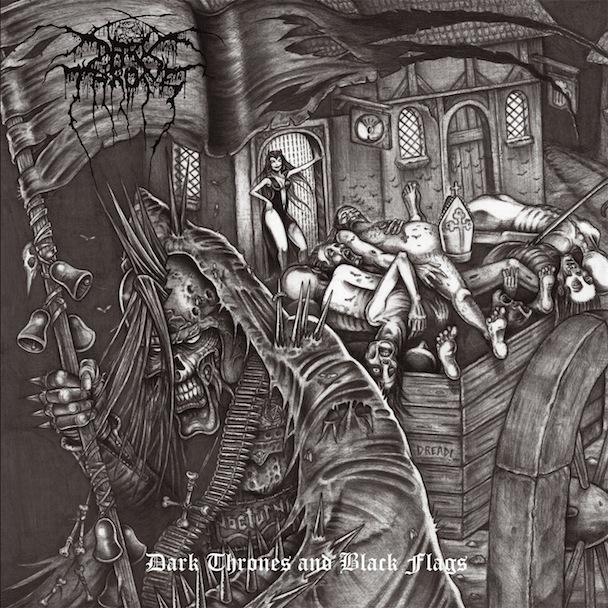
The title of Dark Thrones And Black Flags certainly suggests a heavy punk influence, as does the title of the album's most talked-about song: "Hiking Metal Punks." But in truth, there isn't much actual punk to be found in the songwriting here. Fenriz admitted as much in a 2008 interview, noting that his attitude is more influenced by punk than his music:
2005's The Cult Is Alive boasted more punk elements than 2007's Fuck Off And Die, and the latter boasts more punk elements than Dark Thrones And Black Flags. My attitude is extremely punk oriented, however; we mostly handle things ourselves, and dare to let mistakes be all right. I don't even rehearse my vocals; usually, the first time I sing vocals to a track, those same vocals surface upon the recorded version.
Dark Thrones And Black Flags features a lot of Fenriz vocals — and a lot of mistakes. It also sees Fenriz playing some guitar (lead and rhythm), where he previously only played drums while Nocturno Culto handled all stringed-instrument duties. Fenriz would surely be the first to admit that his own proficiency on the guitar is a fraction of his bandmate's, and as such, one's affection for Dark Thrones And Black Flags is directly commensurate with one's interest in hearing heavy metal played sloppily.
Fortunately, the songs often feel enriched by their imperfections. Both bandmates seem to be playing with energy, abandon, and heart — furthermore, by now, the songs (an even 50-50 Fenriz-Culto split) just feel weird, in the best possible way: primitive in texture, tone, and structure, but almost meta in their retro-worship. Fenriz's vocals are truly an acquired taste — he's plainly sincere, but it still sounds like he's got to be kidding. That, too, adds to the album's astonishing strangeness. And as he did on F.O.A.D., Fenriz is railing against modern metal, and encouraging Darkthrone fans to be equally suspicious — or to fuck off. As he sings in the album's first track, "The Winds They Called The Dungeon Shaker":
We are older and wiser and the underground thrives/ [But] posers are the same with their metal lies/ In a seance of insanity with maniacal screams/ Does your metal knows what metal really means?
8. Dark Thrones And Black Flags (2008)
The title of Dark Thrones And Black Flags certainly suggests a heavy punk influence, as does the title of the album's most talked-about song: "Hiking Metal Punks." But in truth, there isn't much actual punk to be found in the songwriting here. Fenriz admitted as much in a 2008 interview, noting that his attitude is more influenced by punk than his music:
2005's The Cult Is Alive boasted more punk elements than 2007's Fuck Off And Die, and the latter boasts more punk elements than Dark Thrones And Black Flags. My attitude is extremely punk oriented, however; we mostly handle things ourselves, and dare to let mistakes be all right. I don't even rehearse my vocals; usually, the first time I sing vocals to a track, those same vocals surface upon the recorded version.
Dark Thrones And Black Flags features a lot of Fenriz vocals — and a lot of mistakes. It also sees Fenriz playing some guitar (lead and rhythm), where he previously only played drums while Nocturno Culto handled all stringed-instrument duties. Fenriz would surely be the first to admit that his own proficiency on the guitar is a fraction of his bandmate's, and as such, one's affection for Dark Thrones And Black Flags is directly commensurate with one's interest in hearing heavy metal played sloppily.
Fortunately, the songs often feel enriched by their imperfections. Both bandmates seem to be playing with energy, abandon, and heart — furthermore, by now, the songs (an even 50-50 Fenriz-Culto split) just feel weird, in the best possible way: primitive in texture, tone, and structure, but almost meta in their retro-worship. Fenriz's vocals are truly an acquired taste — he's plainly sincere, but it still sounds like he's got to be kidding. That, too, adds to the album's astonishing strangeness. And as he did on F.O.A.D., Fenriz is railing against modern metal, and encouraging Darkthrone fans to be equally suspicious — or to fuck off. As he sings in the album's first track, "The Winds They Called The Dungeon Shaker":
We are older and wiser and the underground thrives/ [But] posers are the same with their metal lies/ In a seance of insanity with maniacal screams/ Does your metal knows what metal really means?
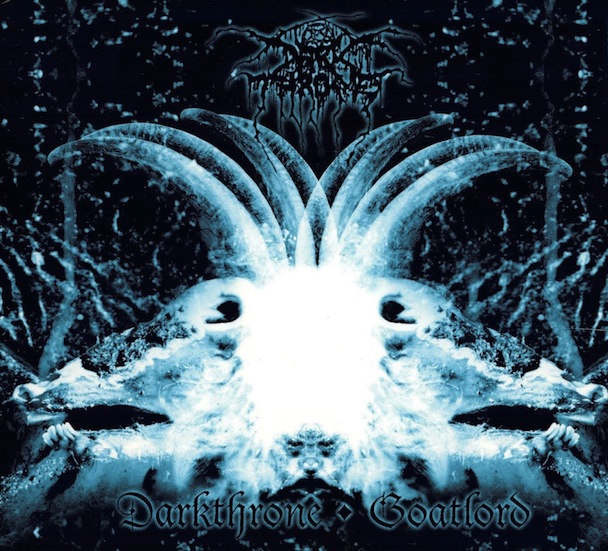
It's not exactly accurate to classify Goatlord as an official Darkthrone "album" — some chroniclers (Wikipedia, for example) catalog it as a demo, although its bizarre backstory and unusual path to release leave it resistant to almost any archival distinction. Still, both band and label (it was initially released on Moonfog, and later reissued by Peaceville) consider it part of the canon, so I'm including it here. No matter what you call it, Goatlord is not only the most out-there work in Darkthrone's immense discography, but one of the strangest collections in the history of recorded music.
Almost immediately after completion of debut album Soulside Journey in 1990, Darkthrone — still a four-piece at this point — started writing and recording material for a follow-up, crafting technical death metal even more complex than that found on their debut. They wrote an entire album's worth of new songs, recorded them (sans vocals) live to cassette in the rehearsal studio and then … decided to change direction entirely, moving from technical death metal to primitive black metal, scrapping the uncompleted Goatlord (the name a tribute to an obscure death-doom band from Las Vegas) and beginning work on what would become their second album, 1992's A Blaze In The Northern Sky.
Then, in 1994 — while Darkthrone were at their creative apex — Fenriz inexplicably dug out the Goatlord rehearsal tape, brought it to the band's home studio, Necrohell, and added vocals to the four-year-old air recordings. (To this point, Fenriz had contributed almost no vocals to any Darkthrone songs; that was Nocturno Culto's job.) Of course, these new vocals were totally incongruous with the music: Fenriz was singing in a variety of styles — black-metal hiss; ominous bellows; horror-movie cackling; tortured howls — adding generous reverb, layering multiple vocal tracks (again, over a single-track rehearsal tape). At his most WTF, he sang in a pitch-shifted operatic "female" voice (or numerous "female" "voices"), seemingly trying to achieve the effect of some sort of ghostly choir. Then, Fenriz boosted the vocals so high in the mix that they almost drowned out all the instrumentation — which is unedited, ambitious, full of unusual and constantly shifting time signatures, and has the soggy drum sound and uneven volumes you'd hear on any rehearsal tape. Fenriz then shelved his updated version of Goatlord for another two years … until 1996, when the band and then-label Moonfog decided to release it as a new Darkthrone album — odd timing that seems even odder when you consider that the band also released sixth album Total Death the same year.
Regardless of how it came to arrive here, the world is a better place with Goatlord than it would be without. The album truly sounds like nothing else, anywhere, ever, falling somewhere between avant garde and outsider art, except the variety of authorial intents makes even those categorizations inaccurate: It began life as a technical death metal album with four musicians eagerly adding new parts and twists to unformed songs, then its evolution was halted, and when it began again, it was under the stewardship of one man attempting to make songs that sounded like Autopsy demos sound like early King Diamond recordings. Needless to say, the album has its detractors: Goatlord is uneasy listening even compared to Darkthrone's most necro work. Many fans regard it as a nadir; others as an unnecessary curio; and others as a minor highlight. And then, there is a camp that sees it as the finest single work in the band's catalog. Among that latter group is Agalloch/Ludicra drummer Aesop Dekker, who wrote about the album on his obscuro-metal blog Cosmic Hearse, calling it, "discomforting and intimate…. This is the most kult release by the most kult band. That alone should be enough for you."
7. Goatlord (1996)
It's not exactly accurate to classify Goatlord as an official Darkthrone "album" — some chroniclers (Wikipedia, for example) catalog it as a demo, although its bizarre backstory and unusual path to release leave it resistant to almost any archival distinction. Still, both band and label (it was initially released on Moonfog, and later reissued by Peaceville) consider it part of the canon, so I'm including it here. No matter what you call it, Goatlord is not only the most out-there work in Darkthrone's immense discography, but one of the strangest collections in the history of recorded music.
Almost immediately after completion of debut album Soulside Journey in 1990, Darkthrone — still a four-piece at this point — started writing and recording material for a follow-up, crafting technical death metal even more complex than that found on their debut. They wrote an entire album's worth of new songs, recorded them (sans vocals) live to cassette in the rehearsal studio and then … decided to change direction entirely, moving from technical death metal to primitive black metal, scrapping the uncompleted Goatlord (the name a tribute to an obscure death-doom band from Las Vegas) and beginning work on what would become their second album, 1992's A Blaze In The Northern Sky.
Then, in 1994 — while Darkthrone were at their creative apex — Fenriz inexplicably dug out the Goatlord rehearsal tape, brought it to the band's home studio, Necrohell, and added vocals to the four-year-old air recordings. (To this point, Fenriz had contributed almost no vocals to any Darkthrone songs; that was Nocturno Culto's job.) Of course, these new vocals were totally incongruous with the music: Fenriz was singing in a variety of styles — black-metal hiss; ominous bellows; horror-movie cackling; tortured howls — adding generous reverb, layering multiple vocal tracks (again, over a single-track rehearsal tape). At his most WTF, he sang in a pitch-shifted operatic "female" voice (or numerous "female" "voices"), seemingly trying to achieve the effect of some sort of ghostly choir. Then, Fenriz boosted the vocals so high in the mix that they almost drowned out all the instrumentation — which is unedited, ambitious, full of unusual and constantly shifting time signatures, and has the soggy drum sound and uneven volumes you'd hear on any rehearsal tape. Fenriz then shelved his updated version of Goatlord for another two years … until 1996, when the band and then-label Moonfog decided to release it as a new Darkthrone album — odd timing that seems even odder when you consider that the band also released sixth album Total Death the same year.
Regardless of how it came to arrive here, the world is a better place with Goatlord than it would be without. The album truly sounds like nothing else, anywhere, ever, falling somewhere between avant garde and outsider art, except the variety of authorial intents makes even those categorizations inaccurate: It began life as a technical death metal album with four musicians eagerly adding new parts and twists to unformed songs, then its evolution was halted, and when it began again, it was under the stewardship of one man attempting to make songs that sounded like Autopsy demos sound like early King Diamond recordings. Needless to say, the album has its detractors: Goatlord is uneasy listening even compared to Darkthrone's most necro work. Many fans regard it as a nadir; others as an unnecessary curio; and others as a minor highlight. And then, there is a camp that sees it as the finest single work in the band's catalog. Among that latter group is Agalloch/Ludicra drummer Aesop Dekker, who wrote about the album on his obscuro-metal blog Cosmic Hearse, calling it, "discomforting and intimate…. This is the most kult release by the most kult band. That alone should be enough for you."
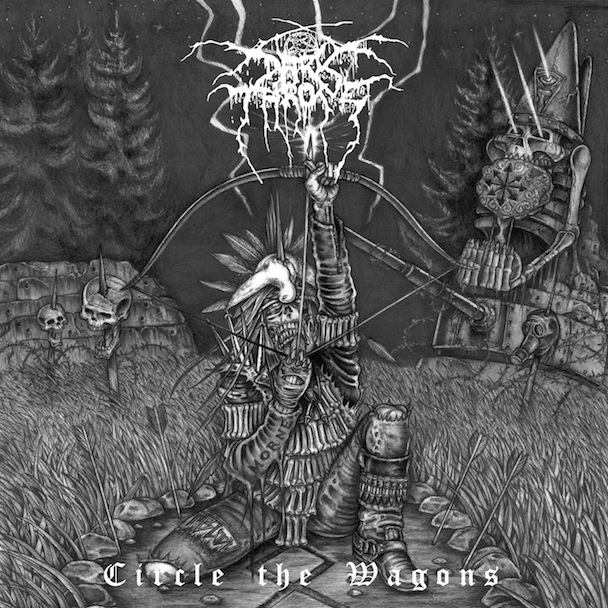
When Darkthrone's 2013 album, The Underground Resistance, is released next month, it will feature sleeve art by Jim Fitzpatrick: the man behind that famous red-and-black Che Guevara portrait and, more crucially, many classic Thin Lizzy album covers. It is likely, then, that 2010's Circle The Wagons will have been the final Darkthrone album to feature Dennis Dread's artwork. The three albums whose artwork was created by Dread (which also include 2007's F.O.A.D. and 2008's Dark Thrones And Black Flags) have a similar sound: riff-heavy, mid-paced NWOBHM-infused metal, more Motörhead than Burzum. Heck, more Maiden than Burzum.
It's tempting, then, to view those albums as a trilogy — the Mr. Necro Trilogy, perhaps (Mr. Necro being, of course, the mascot Dread created for Darkthrone; he's featured on all three of Dread's album covers for the band) — even though the band almost surely did not intend it to be viewed that way. And as an unintentional trilogy, it neatly mirrors the Unholy Trinity of Darkthrone's early career: 1992's A Blaze In The Northern Sky, '93's Under A Funeral Moon, and '94's Transilvanian Hunger. Both sets of albums capture Darkthrone at their most focused and fiercest, although at different aesthetic extremes: the Unholy Trinity is raw, bleak black metal that would come to shape the genre and define its parameters and ideals; the Mr. Necro Trilogy is Darkthrone as revivalists, with no greater interest than bringing "death to modern metal" (a much-repeated Fenriz call to arms) via reproducing the sounds of the '70s and '80s.
In fact, Circle The Wagons features a song called "I Am The Graves Of The '80s," with a chorus that reads: "I am the graves of the '80s/ I am the risen dead/ Destroy their modern metal/ And bang your fucking head." It's a sentiment reflected throughout all Darkthrone's late-career albums, but their delivery of that message has grown stronger with each release. Circle The Wagons is the absolute apex of the Mr. Necro trilogy: It's an assured, commanding set of songs with production that recalls the era it mimics, while still sounding rich, full, and clear.
By this point, Fenriz is sharing equally in vocal duties, and he's exploring the possibilities of his voice, combining a weird and uncomfortable mix of influences: Udo Dirkschneider, Lemmy, Ronny James Dio, Tom G. Warrior, Tim Curry in The Rocky Horror Picture Show … It sounds less like a vocal performance than pastiche; his rolling Rs on the title track might as well have been phrased by Mel Blanc. But it's a total blast, too. With years removed from the depression that derailed him at Darkthrone's apex, and a focus on revivifying the metal of his early youth, Fenriz is on fire throughout Circle The Wagons. (Fenriz on fire is not always a great thing, BTW — the first song released from The Underground Resistance, "Leave No Cross Unturned," features Fenriz at his hammiest; it's rescued by its riffs, but the King Diamond falsetto nearly sinks the damn thing). And Culto is in rare form, delivering the best guitar work of his career, and his own cleanest, most powerful vocals.
Circle The Wagons is nothing short of a triumph, finding the band at peak health after years of illness, and laser-focused after an era of uncertainty and stumbling. Darkthrone will almost certainly never again play black metal as that term is popularly defined (and that definition owes its existence to Darkthrone in the first place). But their new life as a heavy metal band has been inspiring, exciting, and unexpected, too.
6. Circle The Wagons (2010)
When Darkthrone's 2013 album, The Underground Resistance, is released next month, it will feature sleeve art by Jim Fitzpatrick: the man behind that famous red-and-black Che Guevara portrait and, more crucially, many classic Thin Lizzy album covers. It is likely, then, that 2010's Circle The Wagons will have been the final Darkthrone album to feature Dennis Dread's artwork. The three albums whose artwork was created by Dread (which also include 2007's F.O.A.D. and 2008's Dark Thrones And Black Flags) have a similar sound: riff-heavy, mid-paced NWOBHM-infused metal, more Motörhead than Burzum. Heck, more Maiden than Burzum.
It's tempting, then, to view those albums as a trilogy — the Mr. Necro Trilogy, perhaps (Mr. Necro being, of course, the mascot Dread created for Darkthrone; he's featured on all three of Dread's album covers for the band) — even though the band almost surely did not intend it to be viewed that way. And as an unintentional trilogy, it neatly mirrors the Unholy Trinity of Darkthrone's early career: 1992's A Blaze In The Northern Sky, '93's Under A Funeral Moon, and '94's Transilvanian Hunger. Both sets of albums capture Darkthrone at their most focused and fiercest, although at different aesthetic extremes: the Unholy Trinity is raw, bleak black metal that would come to shape the genre and define its parameters and ideals; the Mr. Necro Trilogy is Darkthrone as revivalists, with no greater interest than bringing "death to modern metal" (a much-repeated Fenriz call to arms) via reproducing the sounds of the '70s and '80s.
In fact, Circle The Wagons features a song called "I Am The Graves Of The '80s," with a chorus that reads: "I am the graves of the '80s/ I am the risen dead/ Destroy their modern metal/ And bang your fucking head." It's a sentiment reflected throughout all Darkthrone's late-career albums, but their delivery of that message has grown stronger with each release. Circle The Wagons is the absolute apex of the Mr. Necro trilogy: It's an assured, commanding set of songs with production that recalls the era it mimics, while still sounding rich, full, and clear.
By this point, Fenriz is sharing equally in vocal duties, and he's exploring the possibilities of his voice, combining a weird and uncomfortable mix of influences: Udo Dirkschneider, Lemmy, Ronny James Dio, Tom G. Warrior, Tim Curry in The Rocky Horror Picture Show … It sounds less like a vocal performance than pastiche; his rolling Rs on the title track might as well have been phrased by Mel Blanc. But it's a total blast, too. With years removed from the depression that derailed him at Darkthrone's apex, and a focus on revivifying the metal of his early youth, Fenriz is on fire throughout Circle The Wagons. (Fenriz on fire is not always a great thing, BTW — the first song released from The Underground Resistance, "Leave No Cross Unturned," features Fenriz at his hammiest; it's rescued by its riffs, but the King Diamond falsetto nearly sinks the damn thing). And Culto is in rare form, delivering the best guitar work of his career, and his own cleanest, most powerful vocals.
Circle The Wagons is nothing short of a triumph, finding the band at peak health after years of illness, and laser-focused after an era of uncertainty and stumbling. Darkthrone will almost certainly never again play black metal as that term is popularly defined (and that definition owes its existence to Darkthrone in the first place). But their new life as a heavy metal band has been inspiring, exciting, and unexpected, too.
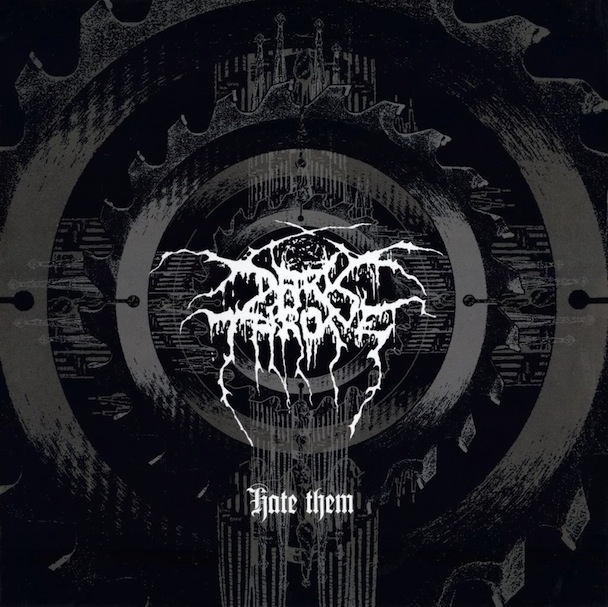
From 1997 to 2002, Darkthrone were either on hiatus or operating at 50-percent efficiency, with Fenriz mostly sidelined by depression while Nocturno Culto carried the band through two albums: 1999's Ravishing Grimness and 2001's Plaguewielder. But entering the studio for what would become '03's Hate Them, the Darkthrone drummer was healthy and invigorated, with a new approach to songwriting. Fenriz contributed three complete songs to Hate Them; Culto was the primary writer for the remaining four tracks here. (Meanwhile, Red Harvest's Lars Sørensen — aka LRZ — delivered a basically unnecessary electronic intro and outro, as he would do again on the band's next album, Sardonic Wrath.) But the full-time return of Fenriz led to a revitalized Culto, too — Hate Them is a ferocious, focused album, the band's best since 1995's Panzerfaust.
Recorded and mixed in December 2002 at Norway's Pan Lydstudio over the course of 26 surely manic hours, Hate Them found Darkthrone in a celebratory mood, musically speaking. Where the band's immediately previous efforts had been somber and pained, and their early work terrifying and bleak, Hate Them just rocked the fuck out. That wasn't entirely new territory for Darkthrone: Panzerfaust was a pretty boisterous set, and '96's Total Death at least made an attempt to connect the band with their trad-metal roots, but neither of those albums did so as efficiently, consistently, or energetically as Hate Them. In the album's commentary, Fenriz notes that his drum sound on Hate Them is solely influenced by "C'Mon Let's Go," a song by all-female NWOBHM demigods Girlschool, included on their 1981 sophomore album, Hit & Run (sample lyric: "Let slow life pass us by/ Another mile another day/ Get some action in our lives/ We're on our way/ Living for today"). It's an indication of Hate Them's wild energy: all huge power-chord riffs and pounding 4/4 rhythms played with full-throttle abandon.
Hate Them isn't exactly a party album but it's an absolute blast of old-school heavy metal, amplified and sped up to ruthless turn-of-the-millennium extremes. A song title like "Fucked Up And Ready To Die" could be read as an admission of defeat or despondency, especially after Fenriz's battles with depression, but here, it sounds like a full-throated yawp to Valhalla. Following Hate Them, Darkthrone ventured much deeper into their punk and trad-metal roots — indeed, this was probably the band's true moment of mid-career rebirth, the possibilities of which they are still exploring today — but they have yet to again capture the wild-eyed magic and organic insanity they achieved here. The album's title is oddly empty and generic, although its nihilistic punk spirit reflects the music. In a 2003 interview with Maelstrom zine, however, Fenriz said that his titular hatred had a small group of specific targets. Very, very specific. And very, very … random:
Maelstrom: The new record is called Hate Them. Who's them?Fenriz: Oh, *them*? Yeah. Well, who do you hate?
Maelstrom: Not that many people, really.
Fenriz: You see? No one wants to come out. I have a list:
I hate the people that make the long-sleeve [T-shirts] that look like they were made by an 8-year-old designer. Like, the logo eight times down the sleeve. You know what I'm saying? Who the fuck...? How old are these people? It's like what you did when you sat in school and just wrote "Kiss, Kiss, Kiss."
I hate the people that designed the subways that we have in Oslo. They want people to sit and face each other. I wonder how that would be if it happened in New York?
Basically, what I can say is, everyone knows that I hate the driving factory in extreme metal.
5. Hate Them (2003)
From 1997 to 2002, Darkthrone were either on hiatus or operating at 50-percent efficiency, with Fenriz mostly sidelined by depression while Nocturno Culto carried the band through two albums: 1999's Ravishing Grimness and 2001's Plaguewielder. But entering the studio for what would become '03's Hate Them, the Darkthrone drummer was healthy and invigorated, with a new approach to songwriting. Fenriz contributed three complete songs to Hate Them; Culto was the primary writer for the remaining four tracks here. (Meanwhile, Red Harvest's Lars Sørensen — aka LRZ — delivered a basically unnecessary electronic intro and outro, as he would do again on the band's next album, Sardonic Wrath.) But the full-time return of Fenriz led to a revitalized Culto, too — Hate Them is a ferocious, focused album, the band's best since 1995's Panzerfaust.
Recorded and mixed in December 2002 at Norway's Pan Lydstudio over the course of 26 surely manic hours, Hate Them found Darkthrone in a celebratory mood, musically speaking. Where the band's immediately previous efforts had been somber and pained, and their early work terrifying and bleak, Hate Them just rocked the fuck out. That wasn't entirely new territory for Darkthrone: Panzerfaust was a pretty boisterous set, and '96's Total Death at least made an attempt to connect the band with their trad-metal roots, but neither of those albums did so as efficiently, consistently, or energetically as Hate Them. In the album's commentary, Fenriz notes that his drum sound on Hate Them is solely influenced by "C'Mon Let's Go," a song by all-female NWOBHM demigods Girlschool, included on their 1981 sophomore album, Hit & Run (sample lyric: "Let slow life pass us by/ Another mile another day/ Get some action in our lives/ We're on our way/ Living for today"). It's an indication of Hate Them's wild energy: all huge power-chord riffs and pounding 4/4 rhythms played with full-throttle abandon.
Hate Them isn't exactly a party album but it's an absolute blast of old-school heavy metal, amplified and sped up to ruthless turn-of-the-millennium extremes. A song title like "Fucked Up And Ready To Die" could be read as an admission of defeat or despondency, especially after Fenriz's battles with depression, but here, it sounds like a full-throated yawp to Valhalla. Following Hate Them, Darkthrone ventured much deeper into their punk and trad-metal roots — indeed, this was probably the band's true moment of mid-career rebirth, the possibilities of which they are still exploring today — but they have yet to again capture the wild-eyed magic and organic insanity they achieved here. The album's title is oddly empty and generic, although its nihilistic punk spirit reflects the music. In a 2003 interview with Maelstrom zine, however, Fenriz said that his titular hatred had a small group of specific targets. Very, very specific. And very, very … random:
Maelstrom: The new record is called Hate Them. Who's them?Fenriz: Oh, *them*? Yeah. Well, who do you hate?
Maelstrom: Not that many people, really.
Fenriz: You see? No one wants to come out. I have a list:
I hate the people that make the long-sleeve [T-shirts] that look like they were made by an 8-year-old designer. Like, the logo eight times down the sleeve. You know what I'm saying? Who the fuck...? How old are these people? It's like what you did when you sat in school and just wrote "Kiss, Kiss, Kiss."
I hate the people that designed the subways that we have in Oslo. They want people to sit and face each other. I wonder how that would be if it happened in New York?
Basically, what I can say is, everyone knows that I hate the driving factory in extreme metal.

Darkthrone's second album, A Blaze In The Northern Sky, is frequently referred to as their first "black metal" album — and compared to the complicated, tightly produced technical death metal featured on debut Soulside Journey, Blaze's raw primitivism did indeed feel like a potent strain of pure black metal. But Blaze came on the heels of the aborted Goatlord sessions, and the band had limited time in the studio to perfect their new vision, so Darkthrone's sophomore album was, ultimately, an unlikely hybrid. (Fenriz has since said that Blaze comprised "three black metal songs and three death metal songs," but in truth, all six songs feel like a unique blend of both styles, with other influences thrown in along the way.) It wasn't till their third album, Under A Funeral Moon, that Darkthrone were a fully operational and focused black metal band.
Going into the studio in the summer of 1992 to record Funeral Moon, Darkthrone's primary goal was to make the coldest album possible, which they achieved in part by playing only open-string chords (giving the guitars a spookier, more atmospheric feel), removing the tom-tom drum from Fenriz's kit, and turning up the volume on his high-hat cymbal and floor tom. More crucially, Funeral Moon took the band's necro sound to new levels of nihilistic inaudibility. As Eduardo Rivadavia wrote in his AllMusic review of the album, "In what must surely qualify as an historic example of anti-production, the record's songs — already shorter and more focused than those of its epic-filled predecessor — were absolutely buried under disfiguring cobwebs of fuzzy amp distortion that effectively made them sound and feel like third-generation cassette copies … of a demo."
Darkthrone's own evolution was concurrent with that of their surrounding community. Between the release of Blaze and the recording of Funeral Moon, the Norwegian black metal scene had grown by leaps and bounds: Bands like Burzum and Immortal had released their full-length debuts; bands like Emperor, Satyricon, and Enslaved had released their first demos; bands like Gorgoroth and Ulver had formed. Perhaps of equal importance, there was almost no media attention to speak of, and the scene was still focused primarily on music: No murders had yet been committed by Norwegian black metal musicians, and only two of eventually almost 30 church-burning incidents connected to the scene had yet occurred. As the community swelled, Fenriz stayed near Oslo — among the "inner circle" that formed around Helvete, the record store owned by Mayhem's Euronymous — but Nocturno Culto and rhythm guitarist Zephyrous moved away from the city, to get away from the scene. (After the recording of Funeral Moon, Zephyrous drifted away from the band, leaving Darkthrone a duo from that point onward, and the physical distance between Fenriz and Nocturno Culto would redefine their songwriting and performance dynamic, not always for the better.)
Under A Funeral Moon is the second part of what would become known as Darkthrone's Unholy Trinity — which started with Blaze and concluded with 1994's Transilvanian Hunger — and like any middle child, it tends to go overlooked: Blaze was the great awakening; Hunger was the climactic conclusion. But Funeral Moon was an apotheosis of sorts. It's the ugliest, most unrelenting Darkthrone album — it's especially disorienting, arrhythmic, and atonal — the one on which they fully immersed themselves in black metal's lightless depths (depths they would never again plumb, in truth).
Discussing Funeral Moon in a 2009 retrospective, both halves of Darkthrone shared similar views on the album. Said Fenriz, "It's 100-percent black metal, nothing more, nothing less." Said Nocturno Culto, "For me, that is still the definition of black metal."
4. Under A Funeral Moon (1993)
Darkthrone's second album, A Blaze In The Northern Sky, is frequently referred to as their first "black metal" album — and compared to the complicated, tightly produced technical death metal featured on debut Soulside Journey, Blaze's raw primitivism did indeed feel like a potent strain of pure black metal. But Blaze came on the heels of the aborted Goatlord sessions, and the band had limited time in the studio to perfect their new vision, so Darkthrone's sophomore album was, ultimately, an unlikely hybrid. (Fenriz has since said that Blaze comprised "three black metal songs and three death metal songs," but in truth, all six songs feel like a unique blend of both styles, with other influences thrown in along the way.) It wasn't till their third album, Under A Funeral Moon, that Darkthrone were a fully operational and focused black metal band.
Going into the studio in the summer of 1992 to record Funeral Moon, Darkthrone's primary goal was to make the coldest album possible, which they achieved in part by playing only open-string chords (giving the guitars a spookier, more atmospheric feel), removing the tom-tom drum from Fenriz's kit, and turning up the volume on his high-hat cymbal and floor tom. More crucially, Funeral Moon took the band's necro sound to new levels of nihilistic inaudibility. As Eduardo Rivadavia wrote in his AllMusic review of the album, "In what must surely qualify as an historic example of anti-production, the record's songs — already shorter and more focused than those of its epic-filled predecessor — were absolutely buried under disfiguring cobwebs of fuzzy amp distortion that effectively made them sound and feel like third-generation cassette copies … of a demo."
Darkthrone's own evolution was concurrent with that of their surrounding community. Between the release of Blaze and the recording of Funeral Moon, the Norwegian black metal scene had grown by leaps and bounds: Bands like Burzum and Immortal had released their full-length debuts; bands like Emperor, Satyricon, and Enslaved had released their first demos; bands like Gorgoroth and Ulver had formed. Perhaps of equal importance, there was almost no media attention to speak of, and the scene was still focused primarily on music: No murders had yet been committed by Norwegian black metal musicians, and only two of eventually almost 30 church-burning incidents connected to the scene had yet occurred. As the community swelled, Fenriz stayed near Oslo — among the "inner circle" that formed around Helvete, the record store owned by Mayhem's Euronymous — but Nocturno Culto and rhythm guitarist Zephyrous moved away from the city, to get away from the scene. (After the recording of Funeral Moon, Zephyrous drifted away from the band, leaving Darkthrone a duo from that point onward, and the physical distance between Fenriz and Nocturno Culto would redefine their songwriting and performance dynamic, not always for the better.)
Under A Funeral Moon is the second part of what would become known as Darkthrone's Unholy Trinity — which started with Blaze and concluded with 1994's Transilvanian Hunger — and like any middle child, it tends to go overlooked: Blaze was the great awakening; Hunger was the climactic conclusion. But Funeral Moon was an apotheosis of sorts. It's the ugliest, most unrelenting Darkthrone album — it's especially disorienting, arrhythmic, and atonal — the one on which they fully immersed themselves in black metal's lightless depths (depths they would never again plumb, in truth).
Discussing Funeral Moon in a 2009 retrospective, both halves of Darkthrone shared similar views on the album. Said Fenriz, "It's 100-percent black metal, nothing more, nothing less." Said Nocturno Culto, "For me, that is still the definition of black metal."
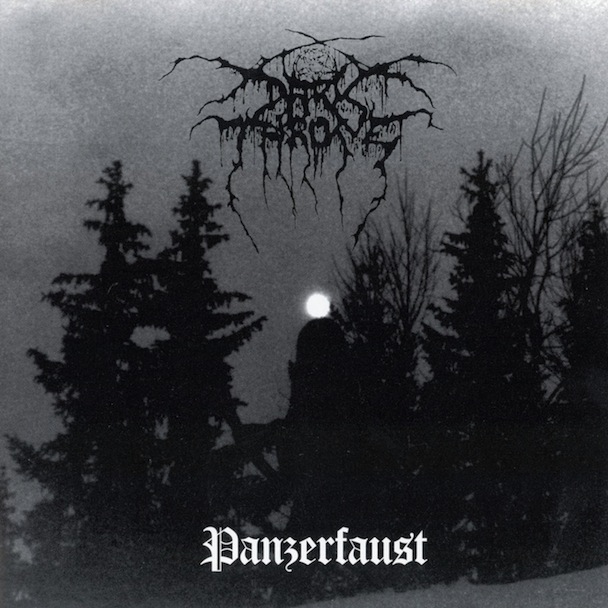
Darkthrone are almost always identified as a black metal band, maybe the black metal band — you can still buy the logo T-shirt that says "True Norwegian Black Metal" on the back — but that designation sort of overlooks the fact that they've spent the majority of their career playing a hybrid form of the genre that often also includes generous elements of punk, thrash, and classic metal. Speaking in the most pedantic terms, only two Darkthrone albums would qualify as "pure" black metal: 1993's Under A Funeral Moon and '94's Transilvanian Hunger. After those two-records, they released Panzerfaust, which found the band incorporating most of their other influences into the genre they had only recently defined.
Panzerfaust (the title refers to a German anti-tank cannon) was the first Darkthrone album of the band's post-Peaceville era; it was released by Moonfog Productions, the label founded by Satyr, of the Norwegian black metal band Satyricon. It was recorded between February and April 1994 at the band's own Necrohell Studios — also where Transilvanian Hunger was recorded, and the sound is similarly filthy — with Fenriz playing all the instruments, and Nocturno Culto adding vocals afterward. A couple songs feature the hyperspeed hypno-guitars employed by the band on Hunger, but much of the album is built of palm-muted primitive thrash riffs reminiscent of early Celtic Frost. (Fenriz has widely cited Celtic Frost as a primary songwriting influence, pointing out in numerous interviews that his infatuation with the band predated their critical rediscovery — to the extent that he wound up printing his own Celtic Frost T-shirts in the early '90s because no stores stocked them at the time.)
In the commentary track for "Hans Siste Vinter" (one of the two Hunger-esque songs included on Panzerfaust) Fenriz notes that the central riff — like every song on Hunger, too — was inspired by early Burzum, and that, really, both his band and Varg Vikernes's Burzum were just aping Bathory, but varying the rhythms:
[Vikernes] would do these melancholic riffs often at a slower pace; I chose this fast pace to do them in. [Long pause] For the record, I think it's better when it's played with slow drums than the fast style. [Pause] But, you know, he'd cornered that market and I cornered this one.
That wasn't the only place Burzum's influence was felt. After writing lyrics to four songs on Hunger, Vikernes contributed one more here: to the album's swelling, climactic closer (not including the bizarre outro featuring Fenriz reading a poem by acclaimed Norwegian writer Tarjei Vesaas), "Quintessence." At this point, Vikernes was serving 21 years in prison for the murder of Euronymous, and soon afterward, he and Fenriz — once close friends — grew apart. In prison, Vikernes embraced and espoused repugnant, bigoted political views, which forced a chasm between the two men. Said Fenriz:
In '94, [Vikernes] started to get really interested in politics, and I mean, I was already a music nerd, but it really exploded for me in '94. I started listening to lots more music. And if your best friend starts getting interested in tennis, and you're just interested in taking photos of various birds, you sort of drift apart. Especially if that tennis guy is going to jail.
Compared to the misanthropy and isolation of the albums that preceded it, Panzerfaust feels like a joyous work. Fenriz has called it "the most necro album we ever did" (indeed, instrumental mistakes abound) as well as "the peak of Darkthrone's insanity." It merits those superlatives, and more.
3. Panzerfaust (1995)
Darkthrone are almost always identified as a black metal band, maybe the black metal band — you can still buy the logo T-shirt that says "True Norwegian Black Metal" on the back — but that designation sort of overlooks the fact that they've spent the majority of their career playing a hybrid form of the genre that often also includes generous elements of punk, thrash, and classic metal. Speaking in the most pedantic terms, only two Darkthrone albums would qualify as "pure" black metal: 1993's Under A Funeral Moon and '94's Transilvanian Hunger. After those two-records, they released Panzerfaust, which found the band incorporating most of their other influences into the genre they had only recently defined.
Panzerfaust (the title refers to a German anti-tank cannon) was the first Darkthrone album of the band's post-Peaceville era; it was released by Moonfog Productions, the label founded by Satyr, of the Norwegian black metal band Satyricon. It was recorded between February and April 1994 at the band's own Necrohell Studios — also where Transilvanian Hunger was recorded, and the sound is similarly filthy — with Fenriz playing all the instruments, and Nocturno Culto adding vocals afterward. A couple songs feature the hyperspeed hypno-guitars employed by the band on Hunger, but much of the album is built of palm-muted primitive thrash riffs reminiscent of early Celtic Frost. (Fenriz has widely cited Celtic Frost as a primary songwriting influence, pointing out in numerous interviews that his infatuation with the band predated their critical rediscovery — to the extent that he wound up printing his own Celtic Frost T-shirts in the early '90s because no stores stocked them at the time.)
In the commentary track for "Hans Siste Vinter" (one of the two Hunger-esque songs included on Panzerfaust) Fenriz notes that the central riff — like every song on Hunger, too — was inspired by early Burzum, and that, really, both his band and Varg Vikernes's Burzum were just aping Bathory, but varying the rhythms:
[Vikernes] would do these melancholic riffs often at a slower pace; I chose this fast pace to do them in. [Long pause] For the record, I think it's better when it's played with slow drums than the fast style. [Pause] But, you know, he'd cornered that market and I cornered this one.
That wasn't the only place Burzum's influence was felt. After writing lyrics to four songs on Hunger, Vikernes contributed one more here: to the album's swelling, climactic closer (not including the bizarre outro featuring Fenriz reading a poem by acclaimed Norwegian writer Tarjei Vesaas), "Quintessence." At this point, Vikernes was serving 21 years in prison for the murder of Euronymous, and soon afterward, he and Fenriz — once close friends — grew apart. In prison, Vikernes embraced and espoused repugnant, bigoted political views, which forced a chasm between the two men. Said Fenriz:
In '94, [Vikernes] started to get really interested in politics, and I mean, I was already a music nerd, but it really exploded for me in '94. I started listening to lots more music. And if your best friend starts getting interested in tennis, and you're just interested in taking photos of various birds, you sort of drift apart. Especially if that tennis guy is going to jail.
Compared to the misanthropy and isolation of the albums that preceded it, Panzerfaust feels like a joyous work. Fenriz has called it "the most necro album we ever did" (indeed, instrumental mistakes abound) as well as "the peak of Darkthrone's insanity." It merits those superlatives, and more.
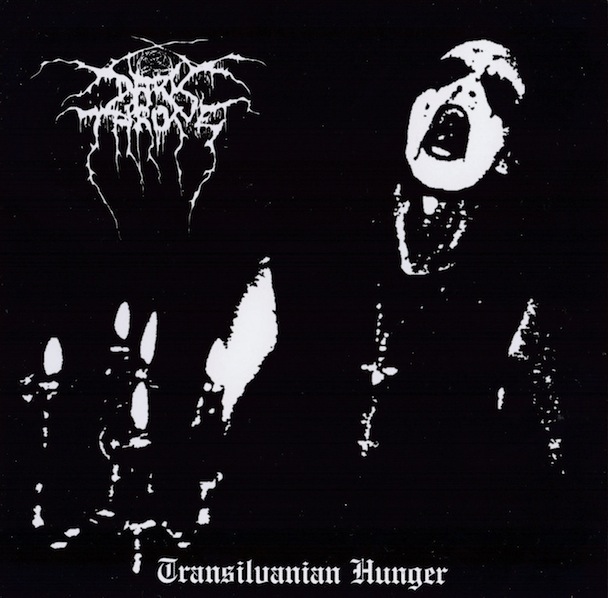
There is no image in black metal's entire history more iconic than the sleeve art of Transilvanian Hunger: a grainy, badly distorted black-and-white photograph of Fenriz in corpsepaint wielding a candelabra and howling … in agony? Rapture? It's a stunning, unforgettable image, as stark and blurry as a Rorshach inkblot; it looks like a vampire photograph cut from the pages of the Weekly World News, which has been xeroxed, then faxed, then pasted into the pages of a punk zine. It's the silk-screened picture seen on the only black metal T-shirt owned by every non-black metal fan (although nearly every serious black metal fan owns that T-shirt, too). It's the perfect visual representation of Darkthrone's music at the time: obscure, occult, minimalistic, degraded to the point of abstraction, and pretty fucking chilling.
Following three albums recorded in fairly large studios (one at Sunlight in Sweden, two at Creative Sound in Norway), Transilvanian Hunger was recorded on a four-track at the band's own Valhall Studio (later known as Necrohell Studio). Fenriz has said in interviews that it was there, and on that album, that the band finally achieved the "dead fucking cold" sound they were going for on Under A Funeral Moon. By this point, Zephyrous was no longer with the band; only Fenriz and Nocturno Culto remained. The album has two songs with lyrics in English, six songs with lyrics in Norwegian — and four of those songs' lyrics were written by Varg Vikernes, aka Burzum, who was in jail at the time the album was recorded, after being arrested for the violent murder of Euronymous, numerous charges of arson, and stealing and storing explosives and electronic detonators. (Vikernes wrote the lyrics while in custody awaiting trial.) Several months after Hunger's release, Vikernes was found guilty on nearly all the charges leveled against him, and sentenced to 21 years in prison. This connection, among other things, served to shroud the album in ugly controversy, and likely helped lead to Darkthrone's split with Peaceville following Hunger (though the band returned to the label in 2005, and the two parties have been working together steadily since then).
The album's title, too, is a source of dubious conjecture — it's been rumored (and never explicitly refuted) that the misspelling of Transylvania is intentional: When Mayhem singer Pelle "Dead" Ohlin killed himself with a shotgun blast, he was found — by Euronymous — wearing a T-shirt reading "I [Heart] Transilvania." Then, as the (fabricated) apocrypha tells it, upon finding the corpse, Euronymous allegedly scooped up bits of brain, cooked them into a stew, and ate them … voila: Transilvanian Hunger.
Hunger is the final chapter of Darkthrone's Unholy Trinity, and by many accounts, the most accessible of all their black metal albums — though we're speaking in relative terms here; it's still a murky, scathing work. That relative accessibility comes mostly due to the riffs — probably the catchiest of the band's early career — and their presentation: Fenriz plays the same rudimentary drumbeat for the first half of the album, and the guitars churn, swirl, and cascade, repeating patterns and melodies set to a single rhythm, building to a hypnotic blur that can be totally mesmerizing, transporting, and meditative. On the two albums prior to this one, Darkthrone was trying to create ever-colder, -grimmer sounds, but Transilvanian Hunger is the band's only album to truly capture the darkness of winter, the terrifying enormity of the Norwegian wilderness.
2. Transilvanian Hunger (1994)
There is no image in black metal's entire history more iconic than the sleeve art of Transilvanian Hunger: a grainy, badly distorted black-and-white photograph of Fenriz in corpsepaint wielding a candelabra and howling … in agony? Rapture? It's a stunning, unforgettable image, as stark and blurry as a Rorshach inkblot; it looks like a vampire photograph cut from the pages of the Weekly World News, which has been xeroxed, then faxed, then pasted into the pages of a punk zine. It's the silk-screened picture seen on the only black metal T-shirt owned by every non-black metal fan (although nearly every serious black metal fan owns that T-shirt, too). It's the perfect visual representation of Darkthrone's music at the time: obscure, occult, minimalistic, degraded to the point of abstraction, and pretty fucking chilling.
Following three albums recorded in fairly large studios (one at Sunlight in Sweden, two at Creative Sound in Norway), Transilvanian Hunger was recorded on a four-track at the band's own Valhall Studio (later known as Necrohell Studio). Fenriz has said in interviews that it was there, and on that album, that the band finally achieved the "dead fucking cold" sound they were going for on Under A Funeral Moon. By this point, Zephyrous was no longer with the band; only Fenriz and Nocturno Culto remained. The album has two songs with lyrics in English, six songs with lyrics in Norwegian — and four of those songs' lyrics were written by Varg Vikernes, aka Burzum, who was in jail at the time the album was recorded, after being arrested for the violent murder of Euronymous, numerous charges of arson, and stealing and storing explosives and electronic detonators. (Vikernes wrote the lyrics while in custody awaiting trial.) Several months after Hunger's release, Vikernes was found guilty on nearly all the charges leveled against him, and sentenced to 21 years in prison. This connection, among other things, served to shroud the album in ugly controversy, and likely helped lead to Darkthrone's split with Peaceville following Hunger (though the band returned to the label in 2005, and the two parties have been working together steadily since then).
The album's title, too, is a source of dubious conjecture — it's been rumored (and never explicitly refuted) that the misspelling of Transylvania is intentional: When Mayhem singer Pelle "Dead" Ohlin killed himself with a shotgun blast, he was found — by Euronymous — wearing a T-shirt reading "I [Heart] Transilvania." Then, as the (fabricated) apocrypha tells it, upon finding the corpse, Euronymous allegedly scooped up bits of brain, cooked them into a stew, and ate them … voila: Transilvanian Hunger.
Hunger is the final chapter of Darkthrone's Unholy Trinity, and by many accounts, the most accessible of all their black metal albums — though we're speaking in relative terms here; it's still a murky, scathing work. That relative accessibility comes mostly due to the riffs — probably the catchiest of the band's early career — and their presentation: Fenriz plays the same rudimentary drumbeat for the first half of the album, and the guitars churn, swirl, and cascade, repeating patterns and melodies set to a single rhythm, building to a hypnotic blur that can be totally mesmerizing, transporting, and meditative. On the two albums prior to this one, Darkthrone was trying to create ever-colder, -grimmer sounds, but Transilvanian Hunger is the band's only album to truly capture the darkness of winter, the terrifying enormity of the Norwegian wilderness.
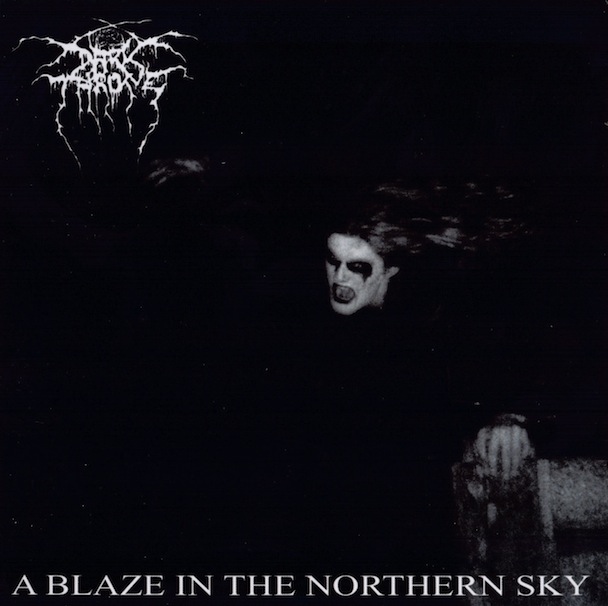
Darkthrone is black metal's most archetypal band, and they're also the source of many archetypes belonging to the genre — almost all of which were born, fully formed, on the band's second album, A Blaze In The Northern Sky.
Most immediately, there is that cover art: a high-contrast black-and-white photograph of rhythm guitarist Zephyrous; only his corpse-painted face, wind-blown hair, and clawed hands are visible. He looks undead, airborne, like he is descending quickly on terrified prey. It was the first of four Darkthrone album covers to employ that stark, minimalistic approach: Nocturno Culto is the demonic figure in the trees on the cover of Under A Funeral Moon; Fenriz is the grim apparition on the cover of Transilvanian Hunger; and finally, on the cover of Panzerfaust, it is just the full moon and Norwegian forest in winter. After that, Darkthrone would experiment with other styles, but black metal's visual aesthetic had been cast in stone — since 1992, seemingly every black metal band in the world has released at least one album whose cover art owes a debt to A Blaze In The Northern Sky.
Then, there is that sound: primitive, raw, no-fi. Recorded in 1991 at Creative Studios in Kolbotn, Norway — where Mayhem's first release, the savage, no-frills Deathcrush EP, was recorded — Blaze buzzes unsteadily and violently. This is the birth of the necro sound. Bassist Dag Nilsen parted ways with the band during the recording of Blaze because he was unhappy with the band's new direction; he wanted to continue playing technical death metal (he did contribute to the album as a session bassist). The band's then-label, Peaceville, reacted negatively to Blaze when Darkthrone submitted the masters, initially thinking it was a joke, then insisting the band remix the album. (The band refused, threatening to split with Peaceville and release the album with Deathlike Silence, the label run by Euronymous. Eventually, Peaceville relented, releasing the album as delivered by the band.) But on Blaze, the band's necro sound hadn't reached its most unrelenting extreme — the album was recorded in a studio, after all, not on a home four-track (or a boom box) — and that works to its benefit. The tone is harsh and ugly, but the strong individual performances cut through the squall.
Finally, there is that music: Almost immediately after its release, Darkthrone absolutely disowned Soulside Journey — in a 1991 interview, Fenriz called his band's debut "a silly, trendy death metal record … we hate everything concerning death metal now!" That seems slightly hyperbolic: Blaze has clear traces of death metal in its DNA, in its riffs (including a snippet of music recorded during the Goatlord sessions on "In The Shadow Of The Horns"). But here, Nocturno Culto's vocals have morphed; gone is the guttural death-metal groan he displays on Soulside Journey; in its place is a dry, ominous hiss. It is here that Darkthrone first explore their love of D-beat punk and '80s metal.
Darkthrone's sound underwent an organic evolution beginning with Blaze, and thus, the album does not truly capture the band's quintessence: Transilvanian Hunger is their most recognizable album, and perhaps the one that best exemplifies their longstanding influence; Panzerfaust takes their necro sound to its furthest extreme. But there is no album in Darkthrone's catalog that is so immediate, so powerful, so timeless as Blaze. Never again was their sonic blend quite so diverse — in the album's commentary track, Fenriz happily points out influences ranging from W.A.S.P. to Diamanda Galas — while still presenting a unified voice. It's an album that could have been released in any of the last three decades and it would still sound equally fresh and relevant, even though it was an absolute shock to the metal community's collective system upon the time of its actual release. In that 1991 interview, conducted only days after the band had completed the recording of Blaze, where Fenriz was writing off death metal as a whole and Soulside Journey in particular, he said, "That was the old DARKTHRONE, we just finished our new BLACK METAL album. For us, our second album is the first."
In that instance, Fenriz's hyperbole has, in hindsight, come to seem like understatement. A Blaze In The Northern Sky truly is the first. And its descendants are legion.
1. A Blaze In The Northern Sky (1992)
Darkthrone is black metal's most archetypal band, and they're also the source of many archetypes belonging to the genre — almost all of which were born, fully formed, on the band's second album, A Blaze In The Northern Sky.
Most immediately, there is that cover art: a high-contrast black-and-white photograph of rhythm guitarist Zephyrous; only his corpse-painted face, wind-blown hair, and clawed hands are visible. He looks undead, airborne, like he is descending quickly on terrified prey. It was the first of four Darkthrone album covers to employ that stark, minimalistic approach: Nocturno Culto is the demonic figure in the trees on the cover of Under A Funeral Moon; Fenriz is the grim apparition on the cover of Transilvanian Hunger; and finally, on the cover of Panzerfaust, it is just the full moon and Norwegian forest in winter. After that, Darkthrone would experiment with other styles, but black metal's visual aesthetic had been cast in stone — since 1992, seemingly every black metal band in the world has released at least one album whose cover art owes a debt to A Blaze In The Northern Sky.
Then, there is that sound: primitive, raw, no-fi. Recorded in 1991 at Creative Studios in Kolbotn, Norway — where Mayhem's first release, the savage, no-frills Deathcrush EP, was recorded — Blaze buzzes unsteadily and violently. This is the birth of the necro sound. Bassist Dag Nilsen parted ways with the band during the recording of Blaze because he was unhappy with the band's new direction; he wanted to continue playing technical death metal (he did contribute to the album as a session bassist). The band's then-label, Peaceville, reacted negatively to Blaze when Darkthrone submitted the masters, initially thinking it was a joke, then insisting the band remix the album. (The band refused, threatening to split with Peaceville and release the album with Deathlike Silence, the label run by Euronymous. Eventually, Peaceville relented, releasing the album as delivered by the band.) But on Blaze, the band's necro sound hadn't reached its most unrelenting extreme — the album was recorded in a studio, after all, not on a home four-track (or a boom box) — and that works to its benefit. The tone is harsh and ugly, but the strong individual performances cut through the squall.
Finally, there is that music: Almost immediately after its release, Darkthrone absolutely disowned Soulside Journey — in a 1991 interview, Fenriz called his band's debut "a silly, trendy death metal record … we hate everything concerning death metal now!" That seems slightly hyperbolic: Blaze has clear traces of death metal in its DNA, in its riffs (including a snippet of music recorded during the Goatlord sessions on "In The Shadow Of The Horns"). But here, Nocturno Culto's vocals have morphed; gone is the guttural death-metal groan he displays on Soulside Journey; in its place is a dry, ominous hiss. It is here that Darkthrone first explore their love of D-beat punk and '80s metal.
Darkthrone's sound underwent an organic evolution beginning with Blaze, and thus, the album does not truly capture the band's quintessence: Transilvanian Hunger is their most recognizable album, and perhaps the one that best exemplifies their longstanding influence; Panzerfaust takes their necro sound to its furthest extreme. But there is no album in Darkthrone's catalog that is so immediate, so powerful, so timeless as Blaze. Never again was their sonic blend quite so diverse — in the album's commentary track, Fenriz happily points out influences ranging from W.A.S.P. to Diamanda Galas — while still presenting a unified voice. It's an album that could have been released in any of the last three decades and it would still sound equally fresh and relevant, even though it was an absolute shock to the metal community's collective system upon the time of its actual release. In that 1991 interview, conducted only days after the band had completed the recording of Blaze, where Fenriz was writing off death metal as a whole and Soulside Journey in particular, he said, "That was the old DARKTHRONE, we just finished our new BLACK METAL album. For us, our second album is the first."
In that instance, Fenriz's hyperbole has, in hindsight, come to seem like understatement. A Blaze In The Northern Sky truly is the first. And its descendants are legion.
